Everything you need to know before you visit Bolivia

Nov 3, 2023 • 8 min read
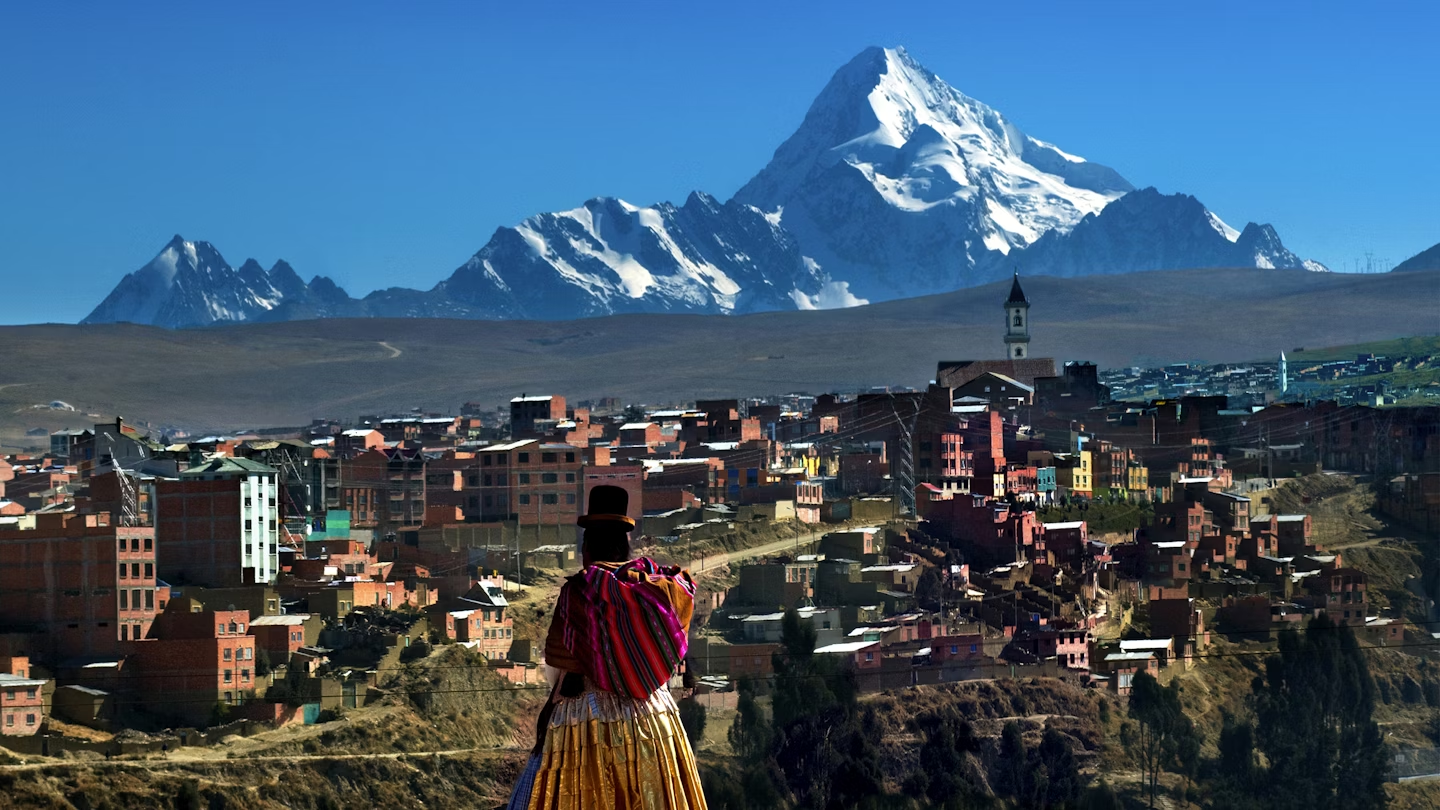
You'll need to do some planning to explore Bolivia's amazing landscapes © John Coletti / Getty Images
In the heart of South America, Bolivia is home to some of the most dramatic landscapes on the continent. From pristine rainforests and high-altitude salt flats to cities rich with cultural diversity, there’s an incredible amount to see, do and experience here.
As an added plus, accommodation, eating out and transportation are all budget friendly, but there are a few things every traveler should know before setting off for Bolivia. Here are our top tips for making the most of your trip.

Planning your trip to Bolivia
There's plenty to think about before you board your flight to Bolivia.
Look beyond the Andes
Bolivia is often described as an Andean country, and many of its top attractions – including Lake Titicaca and the Salar de Uyuni , the world’s largest salt flats – are packed into its mountainous west, an area known as the altiplano (highlands).
But the country is remarkably diverse and you’ll have a much more rewarding experience if you combine Andean adventures with trips to explore some of Bolivia's other fascinating landscapes. As well as the mountains, make time for the tropical Gran Chiquitania region, the arid wilderness of the Chaco, and the Amazon Basin – which covers roughly a third of the country.
Pick the right time to visit
Time your trip to Bolivia to fit in with the weather. It's generally sunny across Bolivia during the high season from May to October, but winter temperatures can drop sharply in the altiplano , so pack warm layers. This is a good time for trekking and other adventure sports, but demand and prices for tours and accommodation are higher than at other times of the year – it’s sensible to book ahead.
The shoulder season from October to November is a particularly good time to visit the Salar de Uyuni, as the spring brings warmer temperatures, while rain remains scarce. The low season (November to April) is hot and rainy, disrupting transport and making many outdoor activities difficult or unappealing, especially in the lowlands.
Check whether you need a tourist visa for Bolivia
Many visitors don’t need a tourist visa to travel to Bolivia – including citizens of the UK, most EU and EEA countries, Canada, Australia, New Zealand, Japan and most nations in South America. But some other travelers – including US citizens – can't visit without a visa. Contact your local Bolivian embassy or consulate to check the latest regulations.

Give yourself a flexible itinerary
Transport delays are common in Bolivia, thanks partly to bloqueos , roadblocks linked to protests that can sometimes last for several days. Allow some leeway in your travel plans, check the news and ask around locally for the latest info.
Flooding during the wet season from November to April can also cause severe transport disruption, particularly in the southeast, so plan accordingly.
Learn a little Spanish
English is spoken quite widely in touristy areas such as Sucre , Uyuni and Rurrenabaque in the Amazon region , but you'll encounter fewer English speakers when you head off the beaten track.
It’s well worth learning some simple Spanish phrases – or better yet taking some formal Spanish lessons – before you arrive in the country. At the very least, learn enough Spanish to help you find the right bus and arrange a meal and hotel room.
Don’t forget to pack the essentials
Whatever the time of year, the weather in Bolivia varies with the terrain. It’s worth bringing a rain jacket, walking boots and sunglasses, plus – if you’re visiting the chilly altiplano – thermal underlayers and a warm fleece.
Carry cash in Bolivia's backwaters
While ATMs ( cajeros automáticos ) are common in cities and larger towns, they can be hard to find in rural areas, so always carry some cash with you. And don’t accept torn, repaired or tatty boliviano notes as change – these can be hard to spend (even though they officially remain legal tender).

Etiquette in Bolivia
Bolivia is a welcoming country, but it’s worth having a basic understanding of the local etiquette before you travel.
Learn some basic greetings
To an extent, Bolivian society is still quite formal. It’s normal to greet someone with a polite buenos días (good morning), buenos tardes (good afternoon) or buenos noches (good night).
When addressing people, use señor or señora (Mr or Mrs) or a formal title such as doctor where appropriate. Stick to the formal usted ("you") for people you don't know well, rather than the informal tú .
On the altiplano , the male and female forms of "friend" – amigo and amiga – are commonly used. Saying please ( por favor ) and thank you ( gracias ) is just good manners. When eating out, buen provecho (enjoy your meal) is another handy phrase to remember.
Be respectful when taking photos of people in Bolivia
Always ask permission before taking a photo of someone, particularly when you’re in the countryside. Many people from Bolivia's minority communities prefer not to be photographed – if someone refuses permission, respect their wishes.

Health and safety in Bolivia
As with other South American destinations, there are some safety precautions to be aware of.
Get your jabs before you travel
If you’re traveling from a country with endemic yellow fever – which includes neighboring Argentina, Brazil, Colombia, Ecuador, Paraguay and Peru – you may be asked to show your yellow fever vaccination certificate at the border. You may also need to show a certificate when traveling to areas of Bolivia below 2500m (8200ft).
It is also advisable to make sure your vaccinations for hepatitis A and tetanus are up to date. Jabs for hepatitis B, diphtheria, typhoid and rabies are also worth considering, particularly if you'll be staying in Bolivia for a while.
Bring antimalarial medication if you’re heading to Bolivia's lowlands
Malaria is present in lowland areas of Bolivia, most notably the Amazon region, so take antimalarial prophylaxis. Travelers have a choice of antimalarial medications – talk to your doctor to find the best option for you.
Always protect yourself against mosquito bites
While antimalarials reduce the risk of catching malaria, they don't eliminate it entirely, and mosquitoes and other biting insects can also spread other diseases such as Dengue fever, Chagas disease and Zika virus.
It’s important to take precautions to avoid being bitten, such as wearing long-sleeved tops, trousers and socks (ideally in light colors), sleeping under a mosquito net and using an effective mosquito repellent. Creams, sprays and plug-in mosquito killers with high concentrations of DEET ( diethyltoluamide) tend to be the best bets.

Prepare for the altitude
Altitude sickness can be a serious problem in western Bolivia. Many tourist destinations are at elevations above 3000m (9840ft), and acute mountain sickness (AMS) is a risk, even if you’re physically fit. This includes the cities of La Paz and Potosí , Lake Titicaca and the Salar de Uyuni , as well as El Alto airport, which at 4062m (13,327ft) is the highest international airport in the world.
The risk of AMS increases the faster you ascend and the higher you climb, and strenuous effort at altitude can also be a factor. Initial symptoms include headaches, nausea, vomiting, dizziness, malaise, insomnia and loss of appetite, but AMS can cause coma and death.
Take the time to acclimatize properly, and pause for rest days without increases in elevation on any sustained climb. Avoid overexerting yourself, eat light meals, avoid alcohol and get plenty of rest.
Some trekkers and climbers take medicines such as acetazolamide or local remedies such as coca leaves and coca tea, but these merely reduce or delay symptoms. If you suffer any serious symptoms of AMS, descend promptly to a lower altitude and seek medical help immediately – altitude sickness can be life-threatening.
Avoid Bolivian tap water
The tap water in Bolivia is not safe to drink, but bottled water is inexpensive and widely available, or you can purify your own. If you plan to go hiking, it’s worth bringing a reverse osmosis water filter and/or water purification tablets to reduce the weight of your backpack and cut down on plastic waste.
Don’t take coca products out of the country
The coca plant has been sacred to people across the Andes for thousands of years and a third of Bolivians regularly chew coca leaves, drink coca tea and consume other coca products. But while the plant is legal in Bolivia, it is illegal almost everywhere else as the leaves are used to produce cocaine. Do not take any coca leaves or coca products home with you – customs authorities take these items very seriously.
Tips for women travelers in Bolivia
There is generally less machismo in Bolivia than in many other South American countries, particularly in Andean cities. However, women travelers still face a certain amount of hassle and harassment, especially during the carnival period (February to March) when men are emboldened by alcohol. Be wary of wandering hands in crowds and avoid walking alone at night or in remote locations.
Advice for LGBTQI+ travelers
The Bolivian constitution expressly bans discrimination based on sexuality or gender identity, but same-sex marriage remains illegal and members of the LBGTQI+ community still face prejudice and discrimination.
There are LGBTQI+ bars and venues in the bigger cities, most notably La Paz and Santa Cruz, which was the setting for Bolivia’s first-ever Pride march in 2001. In rural areas, couples may find it easier to avoid public displays of affection.
This article was first published March 2022 and updated November 2023
Explore related stories
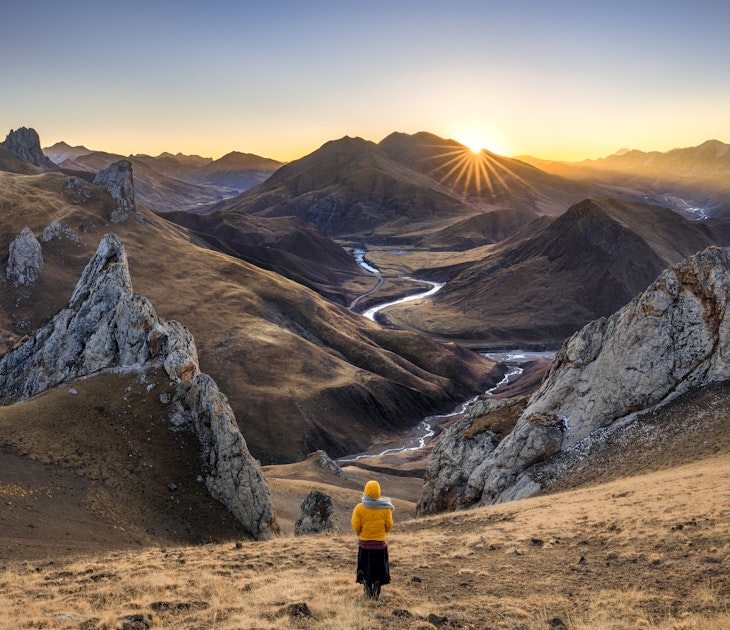
Jan 5, 2024 • 20 min read
As the new year begins, here are 24 of the world’s most life-affirming journeys to consider for nurturing your path to self-discovery.
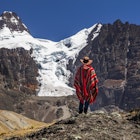
Dec 20, 2023 • 4 min read

Dec 15, 2023 • 7 min read

Nov 18, 2023 • 7 min read

Nov 9, 2023 • 8 min read

Nov 6, 2023 • 8 min read

Oct 28, 2023 • 4 min read

Sep 29, 2022 • 7 min read

Jan 8, 2022 • 6 min read
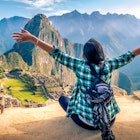
Dec 10, 2021 • 10 min read
This website uses cookies to ensure you get the best experience on our website. Learn more

Information on how to stay safe and healthy abroad. About us.
- Destinations
- South America & Antarctica
- Asia (Central)
- Asia (East)
- Australasia & Pacific
- Central America
- Europe & Russia
- Middle East
- North America
Bolivia (Plurinational State of) (South America)
Advice for all destinations.
Read the information on the COVID-19: Health Considerations for Travel page for advice on travelling during the COVID-19 pandemic.
Vaccinations and malaria risk
Review both the Vaccination and Malaria sections on this page to find out if you may need vaccines and/or a malaria risk assessment before you travel to this country.
If you think you require vaccines and/or malaria risk assessment, you should make an appointment with a travel health professional:
- How to make an appointment with a travel health professional
A travel health risk assessment is also advisable for some people, even when vaccines or malaria tablets are not required.
- Do I need a travel health risk assessment?
Risk prevention advice
Many of the health risks experienced by travellers cannot be prevented by vaccines and other measures need to be taken.
Always make sure you understand the wider risks at your destination and take precautions, including:
- food and water safety
- accident prevention
- avoiding insect bites
- preventing and treating animal bites
- respiratory hygiene
- hand hygiene
Our advice section gives detailed information on minimising specific health risks abroad:
- Travel Health Advice A-Z
Other health considerations
Make sure you have travel insurance before travel to cover healthcare abroad.
Find out if there are any restrictions you need to consider if you are travelling with medicines .
Know how to access healthcare at your destination: see the GOV.UK English speaking doctors and medical facilities: worldwide list
If you feel unwell on your return home from travelling abroad, always seek advice from a healthcare professional and let them know your travel history.
Vaccinations
- Confirm primary courses and boosters are up to date as recommended for life in Britain - including for example, seasonal flu vaccine (if indicated), MMR , vaccines required for occupational risk of exposure, lifestyle risks and underlying medical conditions.
- Courses or boosters usually advised: Hepatitis A; Tetanus.
- Other vaccines to consider: Diphtheria; Rabies; Typhoid; Yellow Fever.
- Selectively advised vaccines - only for those individuals at highest risk: Hepatitis B.
Yellow fever vaccination certificate required for travellers aged 1 year or over arriving from countries with risk of yellow fever transmission .
Notes on the diseases mentioned above
- Diphtheria : spread person to person through respiratory droplets. Risk is higher if mixing with locals in poor, overcrowded living conditions.
Risk is higher where personal hygiene and sanitation is poor.
Risk is higher for long stays, frequent travel and for children (exposed through cuts and scratches), those who may require medical treatment during travel.
- Tetanus : spread through contamination of cuts, burns and wounds with tetanus spores. Spores are found in soil worldwide. A total of 5 doses of tetanus vaccine are recommended for life in the UK. Boosters are usually recommended in a country or situation where the correct treatment of an injury may not be readily available.
- Typhoid : spread mainly through consumption of contaminated food and drink. Risk is higher where access to adequate sanitation and safe water is limited.
- Yellow Fever : spread by the bite of an infected, day-biting mosquito. The disease is mainly found in rural areas of affected countries but outbreaks in urban areas do occur. Vaccination is usually recommended for all those who travel into risk areas. (View yellow fever risk areas here), and areas where there is an outbreak ongoing (check the 'news' section for outbreaks). In addition, certain countries may want to see proof of vaccination on an official yellow fever vaccination certificate - check above under Immunisations .
Malaria is a serious and sometimes fatal disease transmitted by mosquitoes.You cannot be vaccinated against malaria.
Malaria precautions
- Malaria risk is present throughout the year. Risk is highest northern Beni and Pando (especially the localities of Guayaramerin and Riberalta). In eastern and western parts of Beni and in Nor Cinti province in the south risk is not high enough to warrant antimalarial tablets for most travellers, however, it may be considered for certain groups who may be at higher risk (see below under Low risk with additional advice).
- Risk is low in all other areas.
- Malaria precautions are essential. Avoid mosquito bites by covering up with clothing such as long sleeves and long trousers especially after sunset, using insect repellents on exposed skin and, when necessary, sleeping under a mosquito net.
- Check with your doctor or nurse about suitable antimalarial tablets.
- See malaria map – additional information can be found by clicking on the Regional Information icon below the map.
- High risk areas : atovaquone/proguanil OR doxycycline OR mefloquine is usually advised for those visiting risk areas.
- Low risk with additional advice: antimalarial tablets are not usually recommended, however, they can be considered for certain travellers who may be at higher risk e.g. longer stay in rural areas, visiting friends or relatives, those with medical conditions, immunosuppression or those without a spleen. Atovaquone/proguanil OR doxycycline OR mefloquine is advised for those at risk.
- Low to no risk areas: antimalarial tablets are not usually advised.
- If you have been travelling in a malarious area and develop a fever seek medical attention promptly. Remember malaria can develop even up to one year after exposure.
- If travelling to an area remote from medical facilities, carrying standby emergency treatment for malaria may be considered.
Other Health Risks
Altitude and travel, dengue fever.
There is a risk of exposure to coronavirus (COVID-19) in this country.
Please be aware that the risk of COVID-19 in this country may change at short notice and also consider your risk of exposure in any transit countries and from travelling itself.
- The 'News' section on this page will advise if significant case increases or outbreaks have occurred in this country.
Prior to travel, you should:
- Check the latest government guidance on the FCDO Foreign travel advice and country specific pages for travel to this country and the rules for entering the UK on return.
- Ensure you are up to date with UK recommendations on COVID-19 vaccination.
- You can check this in the FAQ's.
- If you are at increased risk of severe COVID-19 you should carefully consider your travel plans and consider seeking medical advice prior to making any decisions.
For further information, see Coronavirus disease (COVID-19) and COVID-19: Health Considerations for Travel pages.
Zika Virus Infection
This country has been categorised as having a risk of Zika (ZIKV) virus transmission.
ZIKV is mainly spread through mosquito bites. The mosquito responsible most commonly bites during daylight hours and is common in towns and cities.
The illness is usually mild but infection during pregnancy may lead to babies being born with birth defects. There is no vaccine currently available against ZIKV.
Advice for All Travellers
You should practice strict mosquito bite avoidance at all times. Do not travel without adequate travel insurance . Seek pre-travel health advice from a travel health professional 6 to 8 weeks in advance of travel.
Additional recommendations for pregnant travellers or those planning pregnancy
If you are planning pregnancy in the very near future you should consider whether you should avoid travel to this country.
- contact your GP, obstetrician or midwife for further advice, even if you have not been unwell or had any symptoms of ZIKV infection
- use barrier methods of contraception during and after travel and for the duration of your pregnancy, even in you have not been unwell or had any symptoms of ZIKV infection
- If you develop symptoms of ZIKV infection, it is recommended that you avoid becoming pregnant for a further 2 months following your recovery
- 2 months afterwards if you are female
- 3 months afterwards if you are male or if both partners travelled
These measures reduce the chance of sexual transmission of ZIKV and/or the risk of ZIKV infection in pregnancy.
For further information, see Zika virus infection page.
- 21 Feb 2024 - Dengue in the Americas and Caribbean: Update 1
- 68 additional items in the news archive for this country
back to top
- KAYAK for Business NEW
Bolivia Travel Restrictions
Traveller's COVID-19 vaccination status
Travelling from the United Kingdom to Bolivia
Open for vaccinated visitors
COVID-19 testing
Not required
Not required for vaccinated visitors
Restaurants
Not required in public spaces and public transportation.
Ready to travel?
Find flights to bolivia, find stays in bolivia, explore more countries on travel restrictions map, destinations you can travel to now, netherlands, new zealand, philippines, switzerland, united arab emirates, united states, know when to go.
Sign up for email alerts as countries begin to open - choose the destinations you're interested in so you're in the know.
Can I travel to Bolivia from the United Kingdom?
Most visitors from the United Kingdom, regardless of vaccination status, can enter Bolivia.
Can I travel to Bolivia if I am vaccinated?
Fully vaccinated visitors from the United Kingdom can enter Bolivia without restrictions.
Can I travel to Bolivia without being vaccinated?
Unvaccinated visitors from the United Kingdom can enter Bolivia without restrictions.
Do I need a COVID test to enter Bolivia?
Visitors from the United Kingdom are not required to present a negative COVID-19 PCR test or antigen result upon entering Bolivia.
Can I travel to Bolivia without quarantine?
Travellers from the United Kingdom are not required to quarantine.
Do I need to wear a mask in Bolivia?
Mask usage in Bolivia is not required in public spaces and public transportation.
Are the restaurants and bars open in Bolivia?
Restaurants in Bolivia are open. Bars in Bolivia are .
- Travel advice
Bolivia travel advice
Explore our complete guide to Bolivia with the latest travel advice for travellers and holidaymakers including official updates and local travel tips for Bolivia.
- Essential travel guide
- Weather & climate
- Travel health
- Covid live updates
- Travel features
- Top travel deals
- Destinations
Bolivia travel guide - essential info
Below is a beginner's guide to Bolivia with essential travel facts such as dominant language spoken, typical flight time from the UK and the local currency. You can also check whether visas are required and what plug adapter you need to pack.
Why visit Bolivia?
Considering a holiday to the Bolivia? Here are some of the very good reasons it makes such a wonderful holiday destination be it for culture or nature to ensure you get the most out of your 2024/2025 escape.
Bolivia tourist information
Recommended for bolivia.

Bolivia deals >>
Back to top
Bolivia weather
The Bolivia weather guide shows long term monthly averages for La Paz .
Bolivia destinations >>
KAYAK: Top UK travel deals of the day

- Save on UK travel with KAYAK's deals of the day
- Find deals for destinations around the world
- Filter by travel deal type, budget & month
View all KAYAK offers
Check the latest travel advice on visiting Bolivia from official government sources (in english) from around the world including entry requirements and travel restrictions.
- UK traveller advice for Bolivia - UK FCDO
- Irish traveller advice for Bolivia - Department of Foreign Affairs, Ireland
- Canadian travel advice for Bolivia - Government of Canada
- US travel advisories for Bolivia - US Department of State
- Safe travel advisories for Bolivia - Ministry of Foreign Affairs, New Zealand
- Smarter traveller advice for Bolivia - Department of Foreign Affairs, Australia
Learn more about the current safety and security risks from terrorism, natural disasters and more. Read about the local laws and customs to consider when travelling around Bolivia.
Note : UK FCDO - UK Foreign, Commonwealth & Development Office
FCDO travel advice
Destination Any destination France Germany Greece India Italy Portugal Spain Turkey USA Algeria Angola Benin Botswana Burkina Faso Burundi Cameroon Cape Verde Central African Republic Chad Congo-Brazzaville Congo-Kinshasa Djibouti Egypt Equatorial Guinea Eritrea Eswatini Ethiopia Gabon Gambia Ghana Guinea Guinea-Bissau Ivory Coast Kenya Lesotho Liberia Libya Malawi Mali Mauritania Morocco Mozambique Namibia Niger Nigeria Rwanda Sao Tome and Principe Senegal Sierra Leone Somalia South Africa South Sudan St Helena, Ascension and Tristan da Cunha Sudan Tanzania Togo Tunisia Uganda Western Sahara Zambia Zimbabwe Falkland Islands South Georgia and South Sandwich Islands Afghanistan Armenia Azerbaijan Bahrain Bangladesh Bhutan Brunei Cambodia China East Timor Gaza Strip Georgia Hong Kong India Indonesia Iran Iraq Israel Japan Jordan Kazakhstan Kuwait Kyrgyzstan Laos Lebanon Macau Malaysia Maldives Mongolia Myanmar Nepal North Korea Oman Pakistan Philippines Qatar Russia (Central Asia) Russia (Far East) Saudi Arabia Singapore South Korea Sri Lanka Syria Taiwan Tajikistan Thailand Turkmenistan UAE Uzbekistan Vietnam West Bank Yemen Anguilla Antigua Aruba Bahamas Barbados Bonaire British Virgin Islands Cayman Islands Cuba Curacao Dominica Dominican Republic Grenada Guadeloupe Haiti Jamaica Martinique Montserrat Saba Sint Eustatius Sint Maarten St Barthelemy St Kitts and Nevis St Lucia St Martin St Vincent and the Grenadines Trinidad and Tobago Turks and Caicos Islands Belize Costa Rica El Salvador Guatemala Honduras Nicaragua Panama Albania Andorra Austria Belarus Belgium Bosnia and Herzegovina Bulgaria Croatia Cyprus Czech Republic Denmark Estonia Faroe Islands Finland France Germany Gibraltar Greece Hungary Iceland Ireland Italy Jan Mayen Kosovo Latvia Liechtenstein Lithuania Luxembourg Macedonia Malta Moldova Monaco Montenegro Netherlands Norway Poland Portugal Romania Russia San Marino Serbia Slovakia Slovenia Spain Svalbard Sweden Switzerland Turkey Ukraine British Indian Ocean Territory Comoros Madagascar Mauritius Mayotte Reunion Seychelles Bermuda Canada Greenland Mexico St Pierre and Miquelon USA Australia Federated States of Micronesia Fiji French Polynesia Kiribati Marshall Islands Nauru New Caledonia New Zealand Palau Papua New Guinea Pitcairn Island Samoa Solomon Islands Tonga Tuvalu Vanuatu Wallis and Futuna Argentina Bolivia Brazil Chile Colombia Ecuador French Guiana Guyana Paraguay Peru Suriname Uruguay Venezuela
Bolivia travel health
Find out more about staying safe when travelling to Bolivia with the latest guidance on required vaccinations and recommended medication to take with you.
- Vaccines & medicines for Bolivia - CDC
- Health & vaccinations for Bolivia - TravelHealthPro, NaTHNac
- How to stay safe & healthy in Bolivia - Fit for Travel, Public Health Scotland
Check out the general travel tips for staying safe and healthy in Bolivia, risks of preventable diseases and what to pack.
Note : CDC - Centers for Disease Control and Prevention
Bolivia covid live updates
Check the latest live updates on Covid-19 in Bolivia with the vaccination requirements, current available statistics and up-to-date travel advice from government agencies.
- Travellers' health for Bolivia - Ministry of Health, Bolivia
- Coronavirus timeline in Bolivia - Our World in Data
Bolivia travel features
Do you want to learn more about Bolivia? Read our latest features covering travel tips and insider destination guides on where to go and what to do in Bolivia.
We don't currently have any travel features on Bolivia. Discover more about holiday destinations around the world with this selection of general travel articles.
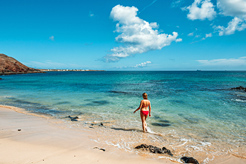
Bolivia FAQs
Read our frequently asked questions about travelling to Bolivia including the current entry restrictions, covid rules, driving side, electrical plugs used and much more.
Are there entry restrictions to Bolivia due to Covid-19?
Bolivia is open for tourism from the UK. Negative PCR or Antigen test results or proof of full Covid-19 vaccination required for arrivals from the UK. Check out Ministry of Health, Bolivia for more information.
Do I need to quarantine in the UK if I travel from Bolivia?
You do not need to quarantine on arrival in the UK from Bolivia. The UK no longer requires a passenger locator form, Covid-19 test or proof of vaccination.
What is the time difference between Bolivia and the UK?
The time difference between Bolivia and the UK is UK time-4 hours .
What is the main language spoken in Bolivia?
The main language spoken in Bolivia is Spanish . Learn a language for Bolivia with Rosetta Stone * , Babbel * and Mondly * .
What is the currency in Bolivia?
The currency in Bolivia is the Bolivian Boliviano ( BOB ). Send money to Bolivia with World Remit * .
Which plugs are used in Bolivia?
Bolivia uses electrical plug type A + C (230 Volts) .
Which side of the road do they drive on in Bolivia?
They drive on the right side of the road in Bolivia. Find out more about driving in Bolivia with International Drivers Association * .
Transport options for Bolivia
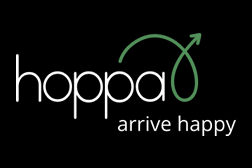
Travel advice by country
Country name All countries - summary Algarve Balearic Islands Barbados Canary Islands Croatia Cyprus Egypt Faroe Islands France Germany Greece Ireland Italy Jamaica Madeira Maldives Malta Portugal Spain Turkey UAE UK USA Algeria Angola Benin Botswana Burkina Faso Burundi Cameroon Cape Verde Central African Republic Chad Congo-Brazzaville Congo-Kinshasa Djibouti Egypt Equatorial Guinea Eritrea Ethiopia Gabon Gambia Ghana Guinea Guinea-Bissau Ivory Coast Kenya Lesotho Liberia Libya Malawi Mali Mauritania Morocco Mozambique Namibia Niger Nigeria Rwanda Sao Tome and Principe Senegal Sierra Leone Somalia South Africa South Sudan Sudan Swaziland Tanzania Togo Tunisia Uganda Western Sahara Zambia Zimbabwe Antarctica French Southern and Antarctic Lands South Georgia and South Sandwich Islands Afghanistan Armenia Azerbaijan Bahrain Bangladesh Bhutan Brunei Cambodia China East Timor Georgia Hong Kong India Indonesia Iran Iraq Israel Japan Jordan Kazakhstan Kuwait Kyrgyzstan Laos Lebanon Macau Malaysia Maldives Mongolia Myanmar Nepal North Korea Oman Pakistan Philippines Qatar Russia (Central Asia) Russia (Far East) Saudi Arabia Singapore South Korea Sri Lanka Syria Taiwan Tajikistan Thailand Turkmenistan UAE Uzbekistan Vietnam Yemen Anguilla Antigua Aruba Bahamas Barbados Bonaire British Virgin Islands Cayman Islands Cuba Curacao Dominica Dominican Republic Grenada Guadeloupe Haiti Jamaica Martinique Montserrat Puerto Rico Saba Sint Eustatius Sint Maarten St Barthelemy St Kitts and Nevis St Lucia St Martin St Vincent and the Grenadines Trinidad and Tobago Turks and Caicos Virgin Islands Belize Costa Rica El Salvador Guatemala Honduras Nicaragua Panama Albania Andorra Austria Belarus Belgium Bosnia and Herzegovina Bulgaria Croatia Cyprus Czech Republic Denmark Estonia Faroe Islands Finland France Germany Gibraltar Greece Guernsey Hungary Iceland Ireland Isle of Man Italy Jan Mayen Jersey Kosovo Latvia Liechtenstein Lithuania Luxembourg Malta Moldova Monaco Montenegro Netherlands North Macedonia Norway Poland Portugal Romania Russia San Marino Serbia Slovakia Slovenia Spain Svalbard Sweden Switzerland Turkey UK Ukraine British Indian Ocean Territory Christmas Island Cocos (Keeling) Islands Comoros Madagascar Mauritius Mayotte Reunion Seychelles Bermuda Canada Greenland Mexico St Pierre and Miquelon USA American Samoa Australia Cook Islands Federated States of Micronesia Fiji French Polynesia Guam Kiribati Marshall Islands Midway Island Nauru New Caledonia New Zealand Niue Norfolk Island Northern Mariana Islands Palau Papua New Guinea Pitcairn Island Samoa Solomon Islands Tokelau Tonga Tuvalu Vanuatu Wake Island Wallis and Futuna Algarve Azores Madeira Argentina Bolivia Brazil Chile Colombia Ecuador Falkland Islands French Guiana Guyana Paraguay Peru Suriname Uruguay Venezuela Balearic Islands Canary Islands England Northern Ireland Scotland Wales Alabama Alaska Arizona Arkansas California Colorado Connecticut D.C. Delaware Florida Georgia Hawaii Idaho Illinois Indiana Iowa Kansas Kentucky Louisiana Maine Maryland Massachusetts Michigan Minnesota Mississippi Missouri Montana Nebraska Nevada New Hampshire New Jersey New Mexico New York North Carolina North Dakota Ohio Oklahoma Oregon Pennsylvania Rhode Island South Carolina South Dakota Tennessee Texas Utah Vermont Virginia Washington West Virginia Wisconsin Wyoming
Be inspired
Get your weekly fix of holiday inspiration from some of the world's best travel writers plus save on your next trip with the latest exclusive offers
We promise not to share your details
Explore holidays in the sun for less
- Beach holidays
- Family holidays
- City breaks
- Summer holidays
- Winter sun holidays
- Holiday offers
- Top travel brands
- Airlines & flights
- Discount hotels
- Airport parking deals
- Jet2holidays
- British Airways
- easyJet holidays
- Love Holidays
- Pinterest (1 share)

TRAVEL to BOLIVIA – Tips and Information Guide [2024]
Whether you’re looking to explore endless salt flats or cycle down the world’s most dangerous road, let our ultimate guide for travel to Bolivia help you plan your trip!
Bolivia has various climates, diverse cultures, attractions for all ages and adventures for the biggest adrenaline junkies.
Depending on what you wish to experience, you can find yourself in the hot lowlands to cold mountain tops.
If you can think of it, Bolivia most likely has it!
- An Amazonian jungle
- Unlivable sweltering deserts
- Incredibly fertile grasslands
- Snowcapped mountains
- And so much more!
Plus there are over 36 different ethnic groups – making it one of the most diverse countries in the world.
But if you are looking for an ocean nearby, that is the one thing Bolivia lacks. It is one of only two landlocked countries in South America.
Still, Bolivia shares the world highest lake with its neighbour, Peru, at Lake Titicaca.
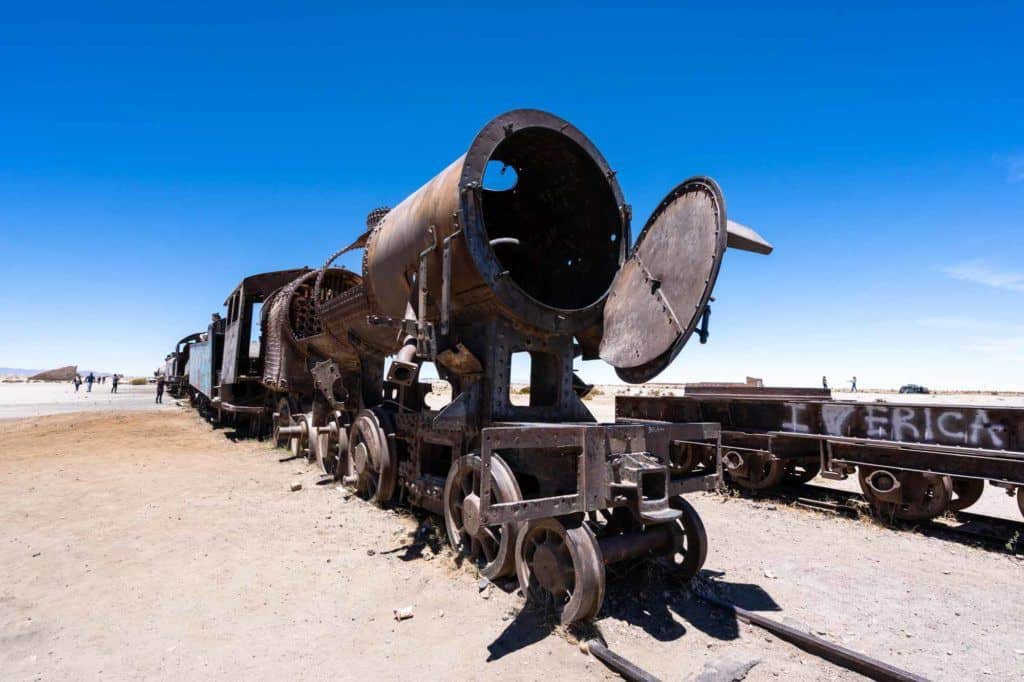
Bolivia Travel Guide
Thinking about travelling to Bolivia as your next holiday destination? Make sure that you use our Bolivia travel guide to prepare you for your adventure!
General Info
Here are a few of the basics to get you started in your planning.
- Capital: Sucre (constitutional capital) and La Paz (seat of the government and de facto capital)
- Other Main Cities: Santa Cruz de la Sierra
- Currency: Boliviano
- Language: Spanish and 36 indigenous languages
- Population: 11,248,864
- Area: 1,098,581 sq. km
- Electricity Voltage: 220 Volt
- Electricity Sockets: Plug type A & C
How to Travel to Bolivia
In general there aren’t that many direct flights to Bolivia.
Most flights originating in other South American countries will land in either La Paz or Santa Cruz de la Sierra, the two most populated cities in Bolivia.
The quickest and easiest way to visit Bolivia is to fly, if you don’t mind the odd connection.
Flying from the US & Canada
From the USA you can fly out from Miami to La Paz and Santa Cruz de la Sierra.
There is also an option to fly from different cities in the US via connections.
Most flights are likely to connect in Miami. And then in Miami, you will make the connection to Bolivia.
When flying from Canada you will also have to first fly to the US and then make your connection.
Of course, if you’re already visiting the neighbouring countries in South America you have a much wider selection of flight connections.
Examples of quick routes include those originating in Sao Paulo (Brazil), Lima (Peru) and Buenos Aires (Argentina).
The main airports in Bolivia are in the two capitals: La Paz and Santa Cruz de la Sierra.
The airplane tickets are on the expensive side, ranging from USD$800-1100.
Flying from United Kingdom & Ireland
Unfortunately there are no direct flights departing from the UK or Ireland.
The quickest route is to fly to Madrid, Sao Paulo, Buenos Aires or Miami from one of the daily flights from London. From there you will connect to Bolivia.
The cost of a round trip ticket is approximately USD$1,500.
Flying from Australia & New Zealand
From Australia and its neighbouring countries, the quickest route is to fly to Buenos Aires, Argentina. You can do this most easily with Qantas or Aerolineas Argentina via Auckland or Sydney.
The cost of the round trip is around USD$1,500.
From Buenos Aires flights to Bolivia will be approximately USD$300-500.
Of course, there is always the option to fly to the USA first and then connect from Miami to Bolivia.
Traveling Overland From The Bordering Countries
The only alternative to flying to Bolivia is to make your way through South America and travel to Bolivia overland by bus, train or automobile.
You can reach Bolivia by bus from all five neighbouring countries: Chile, Peru, Argentina, Paraguay and Brazil.
Take the bus from Puno and enter Bolivia either through the Kasani border or Desaguadero.
The ride is around 4 hours away from La Paz.
The main entry point is Quijarro in Bolivia which is close to the Corumbá, Brazil.
From Quijarro you can make your way to Santa Cruz by train. But be warned that it’s a 13-18 hour long train ride!
From Brazil, you can also enter Bolivia at San Matías. This will be a whole day of bus travel from San Ignacio, Chiquitania.
Another way of travelling to Bolivia is from Amazonia. There are several entry points (Brasiléia, Cobija, Guajarámerim, Guayaramerin).
There are three main routes of travelling to Bolivia from Chile.
- Take the bus departing from Arica to La Paz
- Take the train from Calama to Uyunivia Avaroa
- You can also go on a jeep ride from San Pedro de Atacama to Uyuni
- La Quiaca to Villazón (road and rail connections to Uyuni, Oruro and Tupiza)
- Pcitos to Yacuiba (road and rail connections to Santa Cruz and Tarija)
If you are travelling to Peru from Paraguay it will be a whole day of bus travel from Asunción to Santa Cruz.
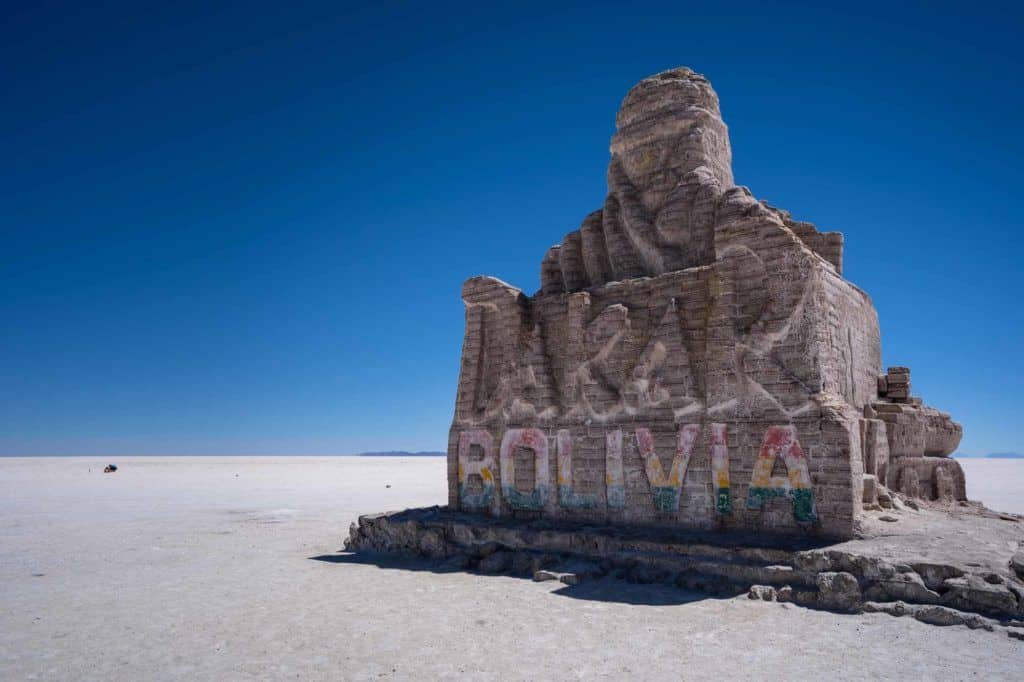
Visa Requirements for Bolivia
If you want to travel to Bolivia you must know whether or not a visa is required to enter the country.
All US citizens are required to purchase an entry visa (USD$160).
For citizens of other countries, the Bolivian government has divided countries into three groups.
- 1 st group: Countries that do not require the visa
- 2 nd group: Countries that require a tourist visa
- 3 rd group: Countries that require a visa with authorization from Bolivia
If you wish to see into which group your country falls in, click here
5 Interesting Facts About Bolivia
Bolivia is full of interesting people, places, history and culture. Here are a few interesting facts to help you plan to travel to Bolivia.
- In about 99% of the country tap water is NOT safe for consumption.
- People dress up as Zebras in La Paz! They help children cross the street and educate drivers and pedestrians about safety measures.
- Camino de las Yungas is known as the “World’s Most Dangerous Road”. Every year the number of casualties ranges from 200 to 300.
- Reflect at the world’s largest mirror – Salar de Uyuni. It is the world’s largest salt flat at 10,582 sq. km.
- Bolivia has 37 official languages! Pick the one you are best at speaking and enjoy your travel in Bolivia!
Best Time to Travel to Bolivia
Bolivia is in the southern hemisphere. For this reason, the best time to travel to Bolivia is during its summer (December – February).
From May to October, the highlands are cold and temperatures in the desert at night are below freezing. This is especially true during the months of June and July.
But temperatures will also vary depending on which region of Bolivia you travel.
For example, the Salar de Uyuni is located in the high desert where even summertime temperatures can range greatly.
Also, when visiting the Amazonian regions of Bolivia the temperatures can remain hot and humid year-round.
The beginning of the dry season is from April to May. The country begins to come alive during these months after all of the rainfall.
If you travel to Bolivia during this time you will benefit from lower prices and fewer tourists.
Bolivia Travel Itineraries
Here’s a typical rundown of places to visit and for how long to help you plan your itinerary.
Lake Titicaca (1 – 2 Days)
If you enter Bolivia from Peru you will reach the town of Copacabana.
You don’t have to spend a night in Copacabana. But it is worth it if anything to relax and take in the sights of the lake.
The first day is to be spent at the lake and go canoeing. Or take a tour out to visit the floating reed cities.
On the second day, explore Copacabana and hike to the top of Cerro Calvario.
La Paz (2 – 3 Days)
Capital city of Bolivia has many attractions worth exploring.
You can go for a ride on the iconic teleferico and enjoy the stunning views of La Paz beneath you.
Or visit the witches market and shop for spells.
You could also spend days at a time trying to visit any of the many impressive museums in the city.
La Paz is also notorious for its nightlife.
If this interests you, head out in the evening and get a taste of it for yourself!
While in La Paz if you’re searching for an adrenaline high cycle down the Camino de las Yungas!
But do be careful as it is known as the “World’s Most Dangerous Road.”
Salar de Uyuni (2 – 3 Days)
The Salar de Uyuni is one of the main reasons that people all over the world travel to Bolivia!
Even if you don’t have a lot of time it is definitely worth booking a three-day trip.
There are many opportunities to travel across the salt flats in any number of tours originating in the town of Uyuni.
Of course, after spending a few days trekking across the surreal landscapes, stay for a night in the town of Uyuni to get some rest.
Sucre (1 – 2 Days)
Sucre is a colonial, picturesque town.
This is a town that’s renowned for having some of the best-preserved colonial architecture in all of South America.
Spend some time enjoying the laid back atmosphere in the town.
And make sure to indulge yourself in the local food and drink while you explore the ancient town.
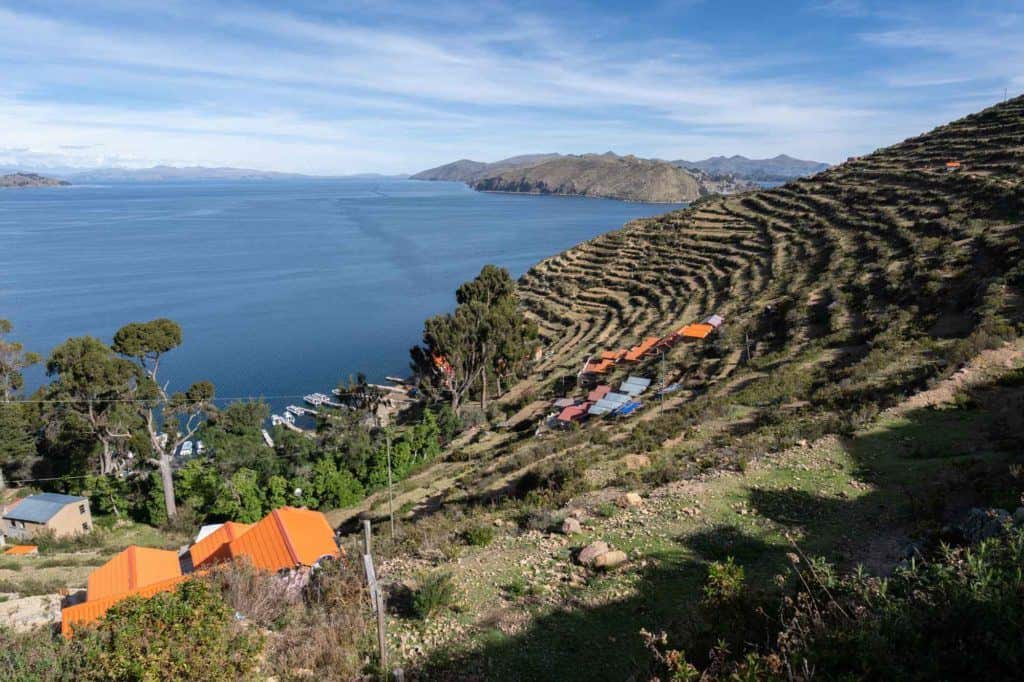
Budget for Travelling Bolivia
Bolivia is known for being a cheap place to travel in South America, but even then it’s easy to spend up big if you want to.
Here’s our general budget guide.
Backpacker – $20 per day
The cheapest accommodations when travelling in Bolivia is definitely camping or staying in budget dorm rooms in hostels.
If you have your own tent it would cost you around USD$5, if you do not find a place to wild camp (be very careful about safety while wild camping though)
But you can also rent tents relatively cheaply as well (around USD$11).
Dorm rooms can cost anywhere from USD$5 to $10 a night.
Food is very cheap in Bolivia. It is almost worth purchasing already prepared meals rather than shopping at grocery stores and preparing your own meals.
If you’re on a really tight budget then head to the markets or street vendors where you can buy fresh fruit salads and hot meals for as low as USD$1.
If you see anywhere that says “almuerzo” that means full lunch. This is a great deal as you will get a soup, main dish and dessert for about USD$1.50!
As for transportation costs as you travel in Bolivia, you also don’t have to worry.
If you take a cab within the city centre limits will cost you around USD$0.60 per person.
While buses offer even lower prices. One way tickets are around USD$0.30.
If you have to take a long bus ride then the price should be around USD$2/per hour.
Make sure you check out our complete guide to backpacking in Bolivia .
Couples/Mid-Range – $60-100 per day
If you are travelling as a couple or have a slightly higher budget, you can live very comfortably in Bolivia.
You can find private rooms for around $20 a night, and if you’re willing to spend between $30-50 a night, you’ll get something very nice in good hotels.
With that kind of budget you’ll also be able to eat in many restaurants, enjoy a tasty coffee if you’d like and head out for a few beers in the evenings.
Luxury – $150 per day
You can live quite well when travelling in Bolivia on USD$100-150 per day.
Four stars hotel like Radisson Hotel in La Paz are about USD$80 per night.
The more expensive restaurants offer meals at around USD$20-30
And most of the museums offer free admission or have very low priced tickets around USD$2-4.
You could also plan to book a good quality 3-day Salar de Uyuni Salt Flats tour for around USD$270 per person . This would include all meals and accommodations.
Even if you wanted to rent a car to tour the country on your own, car rental prices are reasonably set around USD$40 per day.
Top 5 Places to Visit in Bolivia
- La Paz . This capital city is surrounded by snow-capped peaks and offers everything from haute cuisine to lively nightlife.
- Salar de Uyuni. People all over the world travel to Bolivia specifically to witness this natural phenomenon, vast white salt flats stretching into the horizon.
- Reserva Eduardo Avaroa. This is one of the best national parks in the country and can be visited when you are doing your 3-day tour of Salar de Uyuni. Experience hot springs in which you can bathe and enjoy the views, geysers, deserts and several differently coloured lagoons!
- Sucre (White City). The official capital of Bolivia. Sucre is a charming town that is also on UNESCO’s list for its impeccably preserved colonial architecture!
- Santa Cruz de la Sierra. This town is part of Bolivia’s tropical Amazonian area and is the jumping-off point for trips to visit the Amazon. The city also boasts of having the best nightlife in all of Bolivia. For a wild night, you must visit the Monseñor Rivero Street.
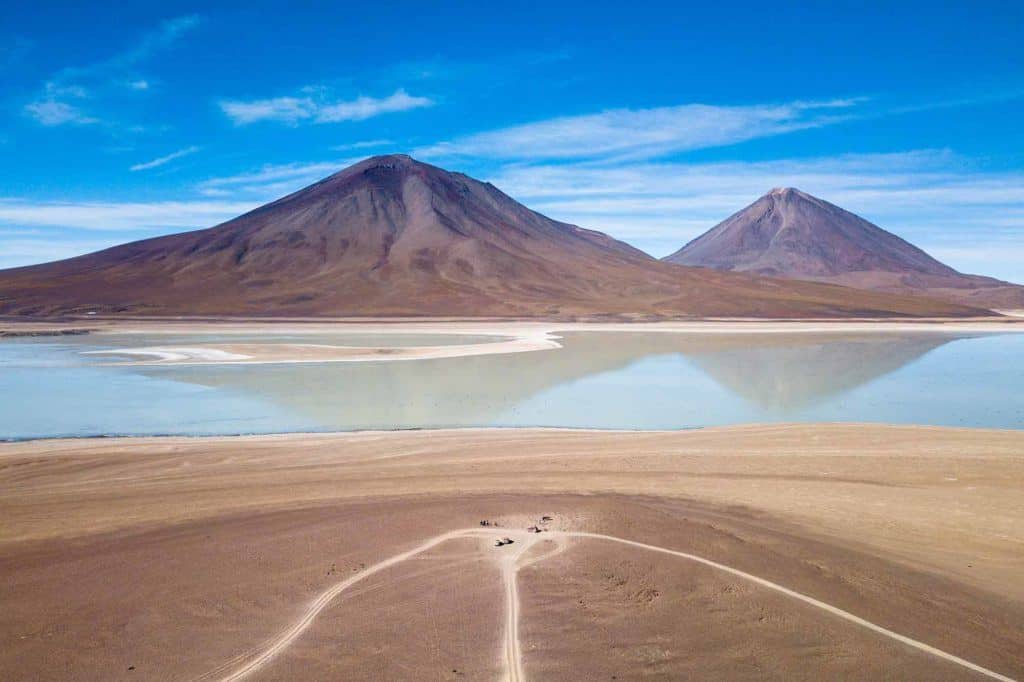
Top 5 Travel Experiences in Bolivia
- The Pampas tour . This is one of two ways in which you can experience the Amazon jungle from Bolivia. Get up close and personal with the Amazons notorious wildlife and landscapes.
- The World’s Most Dangerous Road. This is a must for every thrill-seeker! But be cautioned that it has its name for a reason. Every year hundreds of people die while travelling on the road, including tourists.
- Salar de Uyuni. You cannot miss the world’s largest salt flat! The landscapes surrounding you will take your breath away! Plus you can have all sorts of fun taking photos on the white vastness of the salt flats.
- Madidi National Park. This park is one of the most biodiverse national parks in the world. There are jaguars, rare fauna and over 1,000 species of birds.
- Oruro Carnival. This town comes alive with folk dances, colourful and flamboyant costumes, live music and 20 hours of constant partying. And these are just some of the reasons why this carnival attracts around 400,000 people annually.
Transportation While Travelling in Bolivia
Travelling in Bolivia is both easy and affordable. You will find that it is possible to travel by bus, plane or train to almost any part of the country.
The bus is by far the easiest and cheapest way to travel in Bolivia.
The bus network is very well developed so all the buses are pretty frequent and reliable. You can travel by bus both within and between most cities and towns in Bolivia.
The prices are very low at around USD$0.30 one way. And if you’re going on a longer trip then it’s around USD$2/per hour.
If you’re going on a long bus journey, you should know that there are no meals included in the price.
So prepare some snacks for the trip or buy a hot meal from one of the street vendors that work on one of the stops on your trip.
There are two types of buses for short journeys: micros and trufis.
Micros are minibuses that have an already set route. They leave at any time when the bus is full.
Micros will stop wherever the passenger wants to get off or on. Just let the driver know where you are going and remind them to stop for you.
All tickets cost approximately the same, which is around USD$0.15 one way.
The trufi is a van or a cab that, like the micro, has an already predetermined route. You are typically sharing the ride with a handful of people.
Trufis do not have set schedules either. They only leave when they are full.
They are cheaper than regular taxis because you are carpooling with other passengers.
One way trip would cost about USD$0.40 to most places within a city or town.
Unlike many other places in the world, the taxi is regarded as one of the safest ways to travel in Bolivia.
You can call a cab at any time and anywhere. And they are so numerous that hailing a taxi from the side of the road is quite easy.
There are two types of taxis available: radio taxis and regular taxis.
Radio Taxis
Radio taxis are dispatched based on calls that they receive from private clients like hotels or restaurants.
These taxis drive to the passenger’s location and take them to their desired destination.
This is a safer, but the more expensive, option that would cost you around USD$1 -6.
Regular Taxis
Regular taxis operate throughout most cities and larger towns in Bolivia. These are the standard cabs that you would expect to see in any city in the world.
Taxis are reliable forms of transportation. You can often negotiate fares with taxi drivers.
But note that fares are already quite inexpensive so haggling with a driver is only going to take change out of his or her pocket.
If you are looking for a unique way to travel in Bolivia be sure to check out the cable car.
The teleferico operates at 4000 m in elevation making it the highest cable car in the world.
Riding the cable car will connect you from La Paz to El Alto.
Not only is it able to provide transportation to 3,000 passengers per hour between La Paz and El Alto – but also the duration of the ride is just 10 minutes!
The price of the ride is quite reasonable, at approximately USD$0.50. There are also various discounts for seniors, students and the disabled.
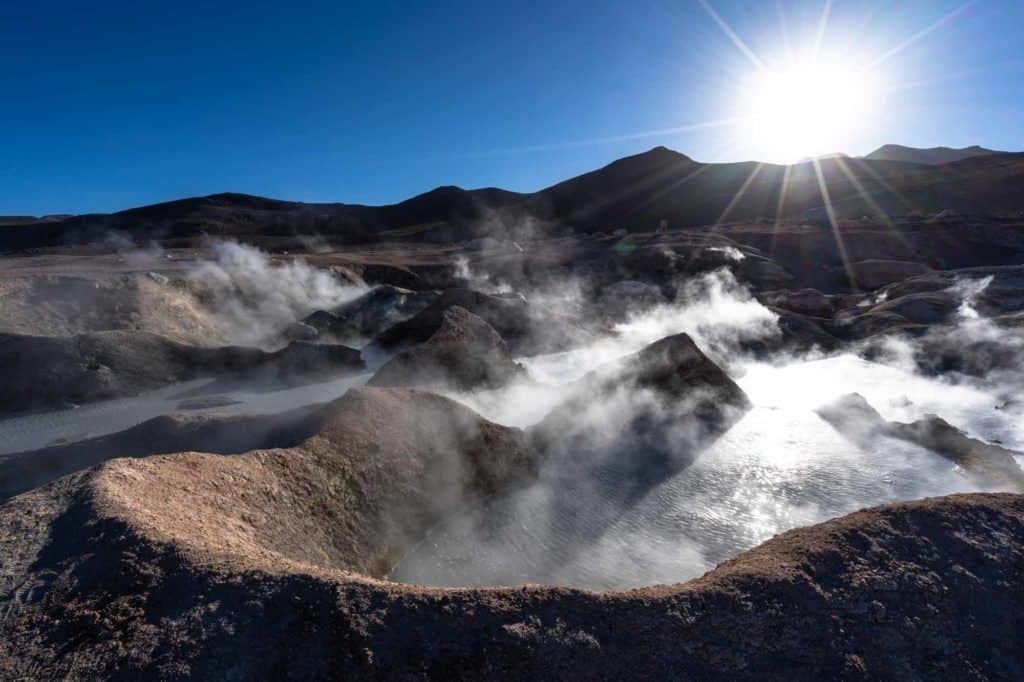
Accommodation in Bolivia
When travelling in Bolivia you can find accommodation for very good prices. But know, of course, that the standards of accommodation vary.
In more urban areas you will find budget hostels for as little as USD$2-3 to high-end hotels that charge USD$100 per night.
In smaller towns, you won’t have that much luck in booking an upper scale accommodation. But there is always a lot of variety when it comes to budget places.
Rates are highest from July to August and in areas that are popular with tourists.
Also, make sure to book in advance if you plan to visit during a major festival.
Many places in Bolivia do not differentiate between a hostel and a hotel. So if you are looking for one or the other, you’ll likely find them to be the same in most places.
Even small basic places will refer to themselves as a hotel. Keep your eye out for other names, such as hostales, residenciales or alojamientos.
These are all different names for basically the same thing.
They offer very simple rooms with shared bathrooms.
There is no real rating system for hotels in Bolivia. So the best way to tell if you should stay at the hotel is to explore a bit.
Usually, the hotel staff will agree to bargain with the price of stay – especially if you notice that the hotel is half empty.
Hostels are slowly popping up all around Bolivia. Most of them are connected to Hostelling International .
But very few hostels have dorms or communal kitchens, which seem standard in most places in the world.
Instead, they offer cheap rooms with a choice of opting out for a private or shared bathroom.
If you wish to explore the wilderness then camping is the perfect choice for you.
Outside of the city and town limits you can usually camp anywhere and almost always for free!
But be advised that in the highlands it gets very cold at night. Meanwhile, in the lowlands, you will have a problem with the mosquitoes.
Attacks on campers are rare but you should still be careful. Use standard safety measures when deciding where to camp.
Never camp by yourself. And women shouldn’t go camping unless they’re accompanied by men.
In national parks and protected areas you can find albergues or refugios.
Those are rustic shelters where you can stay for a very small fee.
Cooking facilities and running water are often available in the national parks.
Food in Bolivia
- Sanduíche de Chola (pork sandwich): This sandwich is a warm bun with slow-cooked ham, pickle of onions and topped with ahi chilli.
- Cuñapé (cheesy bread): Enjoy a bun made out of yucca flour that has cheese cooked inside of them.
- Humintas (baked tamales): These are sweet corn tomales with grated cinnamon (or raisin and sugar) and cheese in the middle. It’s all deliciously packed within a corn husk and then grilled or steamed!
- Chuflay (traditional mixed drink): Sip on ginger ale and singani (a native spirit made from Muscat de Alejandría grapes). It is fruity and spicy at the same time.
- Sonso de yucca (kind of like mashed potatoes, Bolivian style): These are yucas cooked and mashed with cheese.
Safety in Bolivia
Like many South American countries, Bolivia isn’t exactly the safest place to travel through.
Be aware of your surroundings because pickpocketing is on the rise – especially in tourist dense areas, such as Cochabamba, Oruro, Copacabana, Santa Cruz and La Paz.
Avoid withdrawing money from the ATMs at night or isolated locations – that’s usually when thefts are done.
There are also a lot more violent crimes happening, such as kidnapping.
Many times the criminals will target foreigners/tourists, take them hostage and drive them to an ATM where they’re supposed to withdraw money to pay for their own ransom.
Again this is most likely to occur in La Paz.
And, while not common, it is more likely to happen if you take a taxi when the driver is in on the theft.
This is why we encourage you to use only reputable and reliable cab companies.
Like with many countries, Bolivia also isn’t safe for roaming around after dark.
It might be tempting with its famous nightlife but be sure to travel in groups, remain in well-lit areas and call a radio taxi to pick you up if you find that you need a ride somewhere after dark.
Make sure you always get travel insurance wherever you travel. We recommend World Nomads.
Medical System in Bolivia
Because the medical system in Bolivia follows a socialist model, everyone is entitled to some basic care.
It is great that you can get treated for a variety of illnesses for free. But the only thing that’s a bit inconvenient is that the system is under a lot of strain.
They have way too many patients, not enough staff and funding.
So if you have to go to a clinic you will have to get there very early in the morning and be prepared to wait for the whole day.
Also, their public hospitals are notorious for having poor hygiene and being overcrowded.
If possible avoid public hospitals and opt out for private clinics instead.
Packing List for Bolivia
- 1 pair of jeans
- 1 pair of sweatpants
- 1 pair of hiking pants
- 3 pairs of shorts
- Fleece jacket
- 2 long-sleeved shirts
- 1 rain jacket
- 3 tank tops
- 1 pair of comfortable sneakers
- 1 pair of flip flops
- 1 pair of hiking shoes
Miscellaneous Items
- Microfiber towel
- Pair of gloves and scarf
- World plug adapter
Travel Tips for Bolivia
These are our top travel tips for Bolivia. Use common travel sense when travelling in Bolivia the same as you would in any part of the world.
But note the following in particular:
- Water is not safe for consumption. Make sure to carry a bottle with a filter and/or purchase bottled water as necessary. Make sure the bottled water caps are not already open when you purchase them.
- Certain areas in La Paz and other touristy places are very dangerous. Be mindful of your surroundings at all times.
- Make copies of all your important travel documents and plane tickets. If making friends while enjoying the nightlife in Bolivia be sure to keep your documents secure.
- Bring a travel lock and always lock your luggage when you are not around it. Keep an eye on people near your possessions when on public transportation as pickpocketing is a common crime.
Check Out Our Bolivia Blog Posts
The ultimate backpacking in bolivia guide, 11 amazing things to do in la paz, bolivia (2024 edition).
- How to get to Bolivia
Book your individual trip , stress-free with local travel experts
- roughguides.com
- South America
- getting-there
- Travel guide
- Itineraries
- Local Experts
- Travel Advice
- Accommodation
There are relatively few flights to Bolivia. Direct services to the country include departures from Miami in the US, Madrid in Spain, and from neighbouring Latin American countries – the most frequent connections are from São Paulo in Brazil, Buenos Aires in Argentina and Lima in Peru . In Bolivia itself the main international airports are in Santa Cruz and in the capital La Paz . The only alternative to flying is to make your way to South America and travel overland.
Flights from the US and Canada
Flights from the uk and ireland, flights from australia and new zealand, travelling overland from neighbouring countries, tailor-made travel itineraries for bolivia, created by local experts.

4 days / from 1320 USD
Highlights of Bolivia
Bolivia for those on a tight timeline. In just 4 days, you will visit the de facto capital La Paz, a day tour to Lake Titicaca with the beautiful Copacabana town. A short flight to Uyuni will allow you to explore the wonders of salt processing before heading back to La Paz.

16 days / from 5050 USD
Andean Triangle - Chile, Bolivia and Argentina
Start your South American adventure in Santiago de Chile before exploring the wonders of the Atacama desert. A short hop across the border and you'll find yourself in the middle of the Bolivian salt flat. Afterwards, you'll continue to Argentina with Salta and Buenos Aires.

14 days / from 2271 USD
Multi-country adventures from salt flats to the Andes
South America is full of wonders and this trip packs Argentina, Chile and Bolivia into 2 weeks. Bustling Buenos Aires, beautiful valleys around Salta, the surreal looking surroundings of San Pedro de Atacama, the salt flat of Uyuni as well as Lake Titicaca are all part of this itinerary.
Tailor-made trips for Bolivia
Airfares to Bolivia reflect the lack of competition, and are comparatively high. Prices depend on the season: high season runs from July to August and during Christmas and Easter; fares drop during the shoulder seasons (May–June & Sept–Oct) and even more during low season (Jan–April & Nov to late Dec).
If you are travelling to Bolivia from the US, there are direct flights from Miami to La Paz and Santa Cruz. This route takes approximately seven hours. There are regular daily flights to Miami from all major US cities. Alternatively, you can use other airlines like Avianca or Copa to reach Bolivia with a layover en-route.
It’s also possible to fly from other US cities to another South American city (such as São Paulo, Buenos Aires or Lima) and then transfer onto a flight to Bolivia. Passengers from Canada will have to fly via the US and connect with a flight to South America from there.
There are no direct flights from Britain or Ireland to Bolivia. The most direct routes go via Madrid, Miami, Buenos Aires or São Paulo , each of which is connected by daily flights from London; The most convenient routings from Ireland all entail flying through London.
The fastest way to reach South America from Australasia is to fly from Sydney or Auckland to Buenos Aires, in Argentina. It is also possible to fly to Santiago in Chile via Tahiti and Easter Island, but this route is significantly longer and involves lengthy stopovers. Alternatively, you can fly via the US from both Australia and New Zealand.
You can enter Bolivia by land on regular bus services from all five of the countries with which it shares a border – Peru, Brazil, Chile, Argentina and Paraguay – which makes the country easy to include in a wider South American trip.
Crossing the Peruvian border The most widely used route – and also the easiest – is from Puno in Peru on the west shore of Lago Titicaca, via the Kasani border crossing near Copacabana or Desaguadero, south of the lake; both crossings are an easy bus ride (around 4hr) away from La Paz.
Crossing the Brazilian border From Brazil, the main entrance point is at Quijarro, in the far east of Bolivia close to the Brazilian city of Corumbá, which is the main base for visiting the Pantanal region and also well connected to the rest of the country. From Quijarro you can travel to Santa Cruz by train (13hr 30min–18hr 35min). There’s another minor land crossing from Brazil in the far east of Bolivia at San Matías, a day’s bus journey from the town of San Ignacio in Chiquitania. You can also enter Bolivia from Brazil at several points along the northern border in Amazonia, most notably from Brasiléia to Cobija and Guajarámerim to Guayaramerin.
Crossing the Chilean border From Chile there are three main routes, all of them passing through spectacular Andean scenery. You can travel to La Paz by bus along the well-paved road from Arica on the Pacific Coast via the border crossing of Tambo Quemado; take the weekly train from Calama in Chile to Uyunivia Avaroa; or cross the border at Laguna Verde in the far south of the Reserva Eduardo Avaroa on a jeep tour organized from the Chilean town of San Pedro de Atacama, a route which will bring you to Uyuni.
Crossing the Argentinian border From Argentina there are two straightforward crossings: from La Quiaca in Argentina to Villazón in the southern Altiplano, from where there are road and rail connections north to Tupiza, Uyuni and Oruro; and from Pocitos in Argentina to Yacuiba in the Chaco, from where you can travel by road and rail north to Santa Cruz or by road west to Tarija. There’s also a minor crossing at Bermejo, south of Tarija.
Crossing the Paraguayan border In the dry season (May–Sept) you can enter Bolivia on the arduous bus journey from Asunción in the south of Paraguay to Santa Cruz (roughly 1000km/24hr).
The Rough Guides to Bolivia and related travel guides
In-depth, easy-to-use travel guides filled with expert advice.

Travel advice for Bolivia
From travel safety to visa requirements, discover the best tips for traveling to Bolivia
- Eating and drinking in Bolivia
- Getting around Bolivia: Transportation Tips
- Travel Health Bolivia
- Crime and personal safety tips Bolivia
- Culture and Etiquette in Bolivia
- National Parks in Bolivia
- Sports and Outdoor activities in Bolivia
- Travel Tips Bolivia for planning and on the go
- Best time to visit Bolivia
Find even more inspiration here

- Travel Tips

written by Zara Sekhavati
updated 26.04.2021
Ready to travel and discover Bolivia?
Get support from our local experts for stress-free planning & worry-free travels.
- Where to stay
- Travel advice
- Company History
- Mission Statement
- Philippines
- South Africa
- Afghanistan
- American Samoa
- Antigua and Barbuda
- British Virgin Islands
- Burkina Faso
- Canary Islands
- Cayman Islands
- Central African Republic
- Christmas Island
- Cocos (Keeling) Islands
- Cook Islands
- Cote d'Ivoire
- Democratic Republic of the Congo
- Dominican Republic
- Easter Island
- El Salvador
- Equatorial Guinea
- Falkland Islands
- Faroe Islands
- French Guiana
- French Polynesia
- Guinea-Bissau
- Liechtenstein
- Madeira Islands
- Marshall Islands
- Netherlands
- New Caledonia
- New Zealand
- Norfolk Island
- North Korea
- North Macedonia
- Northern Mariana Islands
- Palestinian Territories
- Papua New Guinea
- Pitcairn Islands
- Puerto Rico
- Republic of the Congo
- Saint Barthelemy
- Saint Helena
- Saint Kitts and Nevis
- Saint Lucia
- Saint Martin
- Saint Pierre-et-Miquelon
- Saint Vincent and the Grenadines
- Sao Tome and Principe
- Saudi Arabia
- Sierra Leone
- Sint Eustatius
- Solomon Islands
- South Georgia and the South Sandwich Islands
- South Korea
- South Sudan
- Switzerland
- Trinidad and Tobago
- Turkmenistan
- Turks and Caicos Islands
- U.S. Virgin Islands
- United Arab Emirates
- United Kingdom
- United States
- Wake Island
- Western Sahara
- Travel Vaccines
- Travel Health Consultations
- Travellers’ Diarrhea Kits
- Dengue Fever Prevention
- Malaria Prevention
- Chikungunya Prevention
- Zika Prevention
- Ebola Virus
- Yellow Fever
- Hepatitis A
- Japanese Encephalitis
- Hepatitis B
- Tickborne Encephalitis (TBE)
- Tetanus-Diphtheria-Pertussis
- Measles-Mumps-Rubella
- Influenza (Flu)
- Blood Tests
- Vitamin Injections
- Physician Referral Program
- London – Euston Travel Clinic

Travel Vaccines and Advice for Bolivia

Bolivia is a beautiful, geographically diverse country. With regions of the Andes as well as the basin of the Amazon, it is the ultimate destination for a taste of what South America has to offer.
There are a variety of one-of-a-kind places in Bolivia. If you want to a taste of the rich geographical scenery, check out the Amboro and Carrasco National Parks.
For a journey to the wild side, visit the Madidi National Park, known for being one of the most extensive biodiversity reserves on the planet.
If you are more interested in history, consider visiting Tiwanaku, a UNESCO World Heritage site, home of the ancient ruins of the pre-Columbian Tiwanaku culture.
No matter what your ideal travel activities are, you are bound to find something interesting to see and enjoyable to do in Bolivia.
Do I Need Vaccines for Bolivia?
Yes, some vaccines are recommended or required for Bolivia. The National Travel Health Network and Centre and WHO recommend the following vaccinations for Bolivia: COVID-19 , hepatitis A , hepatitis B , typhoid , yellow fever , rabies and tetanus .
See the bullets below to learn more about some of these key immunisations:
- COVID-19 – Airborne – Recommended for all travellers
- Hepatitis A – Food & Water – Recommended for most travellers to the region, especially if unvaccinated.
- Hepatitis B – Blood & Body Fluids – Recommended for travellers to most regions.
- Tetanus – Wounds or Breaks in Skin – Recommended for travelers to most regions, especially if not previously vaccinated.
- Typhoid – Food & Water – Jab lasts 3 years. Oral vaccine lasts 5 years, must be able to swallow pills. Oral doses must be kept in refrigerator.
- Yellow Fever – Mosquito – Required if arriving from a country with yellow fever. Recommended for all travellers over 9 months travelling east of the Andes at altitudes under 2,300 m.
- Rabies – Saliva of Infected Animals – High risk country. Vaccine recommended for long-stay travellers and those who may come in contact with animals.
See the tables below for more information:
The yellow fever vaccine is recommended for travellers to Bolivia. It may be required if you are coming from a country with known cases such as Peru or Brazil.
Travellers should practice enhanced precautions to avoid contracting the Zika virus . Local mosquitoes can spread the virus, creating more risk for travellers. The virus can cause birth defects. Women who are pregnant or may become pregnant should avoid travelling to Bolivia or take extra precautions.
To prevent mosquito bites, travellers should wear long-sleeved shirts and trousers (preferably permethrin-treated), and stay in buildings with window screens.
To find out more about these vaccines, see our vaccinations page . Ready to travel safely? Book your appointment either ring or start booking online now .
Do I Need a Visa or Passport for Bolivia?
UK citizens do not need a visa to enter Bolivia for stays up to 30 days, which can be extended to 60 at no charge. Passports must be valid for a minimum of six months. Proof of yellow fever vaccination may be required if you are travelling from a region where yellow fever is present.
Sources: Embassy of Bolivia and GOV.UK
What is the Climate Like in Bolivia?
Bolivia’s climate differs from region to region. The three main climates are:
- Llanos (lowlands) – These areas include Santa Cruz, Cobija, Rurrenabaque, and Trinidad. In these regions, the weather can be expected to be an average of 30 and very rainy. The best time to visit this area is from May to September when the temperature is cooler and less rainy.
- Altiplano (highlands) – These areas include Lake Titicaca, Oruro, La Paz, Sucre, Cochabamba, and Uyuni. The weather is dry and sunny in the highlands, with temperatures between 15 and 25.
- Yungus valley (Amazonian lowlands) – These areas include Chulumani, Sorata, and Coroico. The weather is warm and humid, but cool, refreshing breezes keep temperatures tolerable.
How Safe is Bolivia?
It is common in Bolivia for strikes, protests, and various other civic protests to occur. Some measures to take whilst travelling in Bolivia are to avoid roadblocks and to keep extra food, water, and clothing on hand in the event that a roadblock cannot be avoided.
The Embassy of the United Kingdom site provides updates on civic protests in Bolivia. Monitor the site before and during your trip.
Train Travel in Bolivia
Bolivia’s rail system is a great way to view the landscape of the varying terrain. With over 3600 kilometres of track spread throughout the country, visitors use this popular transportation system regularly.
The two railway systems, Ferroviaria Occidental and Ferroviaria Oriental, only have stations open from Monday through Friday.
Train tickets can are available in-person or online before your trip. To contact Bolivia’s train ticket office, refer to the following information below.
What Should I Take To Bolivia?
Here are some essential items to consider for your trip to Bolivia:
- Spanish-English Dictionary – The majority of Bolivians will not know English. Having some sort of translation available will help make travelling easier.
- Layers of Clothing – Bolivia’s weather conditions vary from region to region. It is important to pack layers of clothes to prepare for any sort of conditions that you may encounter.
- Water Filtration – Safe drinking water can be hard to find in some parts of Bolivia. Having a water filter or filtration tablets can make brushing your teeth or everyday drinking easier.
- Medication – Purchasing prescription medication can be difficult in Bolivia. Ensure you bring all necessary medications with you. Altitude sickness medication is recommended for those going to the Altiplano.

Embassy of the United Kingdom in Bolivia
If you are in Bolivia and have an emergency (for example, been attacked, arrested or someone has died) contact the nearest consular services. Contact the embassy before arrival if you have additional questions on entry requirements, safety concerns or are in need of assistance.
British Embassy, La Paz Avenida Arce No. 2732 La Paz La Paz Bolivia Telephone: (591 2) 2433424 Emergency Phone: (591 2) 2433424 Fax: (591 2) 2431073 Contact Form: Click Here
If you have any further questions about health and safety precautions when travelling to Bolivia, schedule a visit with a Passport Health medicine clinic today by calling or book online now .
On This Page: Do I Need Vaccines for Bolivia? Do I Need a Visa or Passport for Bolivia? What is the Climate Like in Bolivia? How Safe is Bolivia? Train Travel in Bolivia What Should I Take To Bolivia? Embassy of the United Kingdom in Bolivia
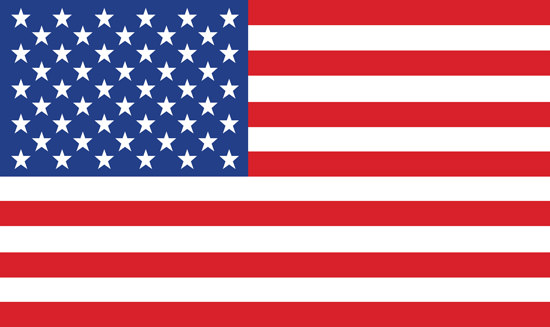
- Privacy Policy
- Automatic Data Collection Statement

Change location
- Call us tomorrow from 9am 01993 838 925 01993 838 645 or
- REQUEST A QUOTE
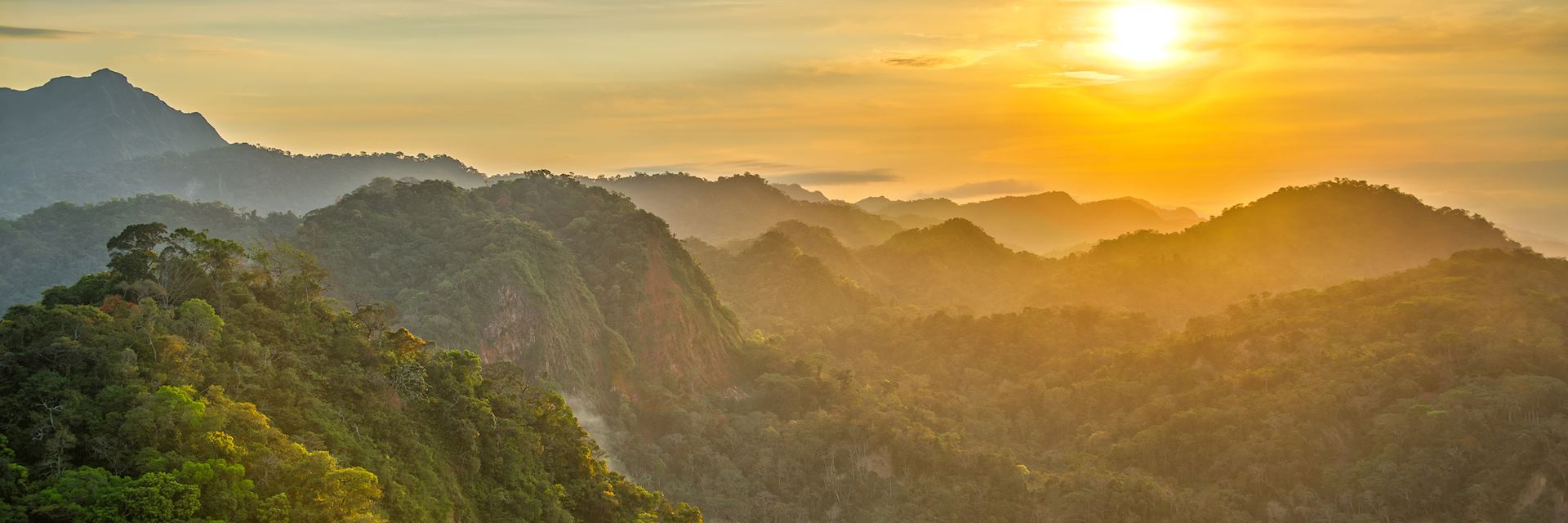
Bolivia holidays 2024 & 2025
Bolivia is struggling to catch up to its Andean bedfellows Peru and Chile, and travel in this isolated land requires a relaxed and open mind. Yet, as our specialists will tell you, what Bolivia lacks in polish (and development), it makes up for in scenic splendour. The great white desert of the Salar de Uyuni salt flats is the first stop on most Bolivia holidays, and our specialists will show you how to explore it to the full. But they’ll also steer you toward the flamingo-haunted lagoons and mud geysers of the Southern Altiplano or the Amazonian savannah of Madidi National Park on your holiday to Bolivia.
Bolivia has a largely indigenous culture, whose lifestyle and crafts have survived Spanish conquistador rule and modern commerce. Our specialists can help you experience it all first-hand, from a visit to La Paz’s witches’ market to breaking bread with Lake Titicaca’s island communities.
- Make an enquiry
- Request a brochure
Suggested tours for Bolivia
These tours give you a starting point for what your holiday to Bolivia could entail. Treat them as inspiration, as each trip is created uniquely for you.
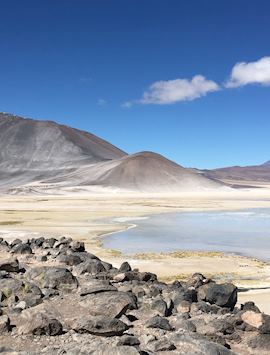
Chile, Bolivia & Peru overland tour
16 days from £7,655pp
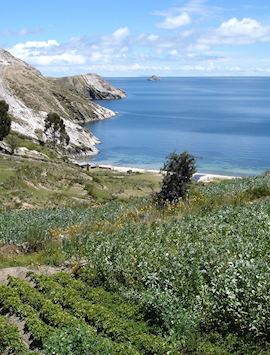
Simply Bolivia: La Paz, Lake Titicaca & Salar de Uyuni
11 days from £6,100pp
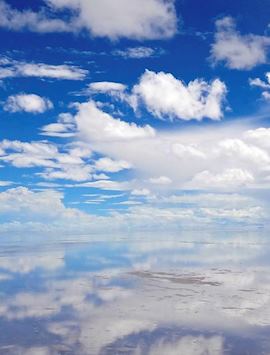
Classic Bolivia tour
12 days from £6,980pp

Grand tour of Bolivia
20 days from £9,400pp
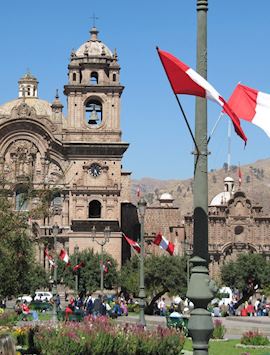
Peru & Bolivia highlights: Machu Picchu, Lake Titicaca, & Uyuni Salt Flats
15 days from £6,700pp
Suggested activities for Bolivia
Whatever your interests, our specialists will build activities into your trip that connect to how you want to experience Bolivia.
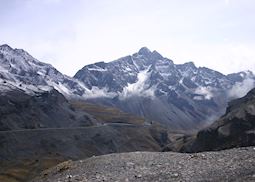
Tour to Coroico
A thrillingly panoramic trip that sees you descend from jagged mountain tops and iced streams to lush subtropical jungle complete with tropical birds and plants.
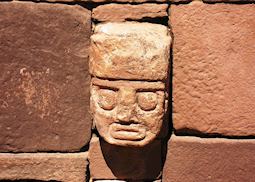
Tiahuanaco Ruins Excursion
Tiwanaku was, during its splendour period, the largest city in the world and it is considered to be "the Cradle of the American Civilisations".
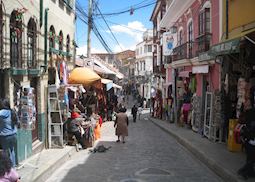
La Paz City Tour
On this tour you have the opportunity to visit sights as diverse as the Witches' Market, where bowler-hatted local ladies sell everything from medicinal herbs to dried llama foetuses.
Why travel with Audley?
- 100% tailor-made tours
- Fully protected travel
- Established for over 25 years
- 98% of our clients would recommend us
Best time to visit
Our specialists advise on the best months to visit Bolivia, including information about climate, events and festivals.
Request our brochure
Covering all seven continents, The World Your Way shows you how you can see the world with us. It features trip ideas from our specialists alongside hand-picked stays and experiences, and introduces our approach to creating meaningful travel experiences.
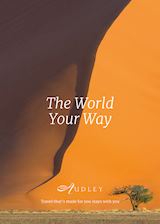
Useful information for planning your holiday in Bolivia
Spanish is the official language of Boliva. In the highlands, you’ll hear the indigenous languages of Quechua and Aymara, too. English is rarely spoken.
The currency of Bolivia is the boliviano (Bs or BOB). You’ll find ATMs in all cities and larger towns, and Visa and Mastercard are quite widely accepted. Changing US dollars in banks is relatively easy but try to spend or exchange all your bolivianos before returning home as they’re virtually impossible to change outside of the country.
For the latest travel advice for Bolivia, including entry requirements, health information, and the safety and security situation, please refer to the Foreign, Commonwealth & Development Office website .
In Bolivia, you should try salteñas (a pastry filled with meat and vegetables), sopa de mani (peanut soup), and anticuchos (grilled skewers of meat). In the lowlands, food is based around rice, yucca, and bananas, while in the highlands, you’ll find grains and potatoes often cooked with spicy stews or hot pepper sauces.
Other foods to look out for include mondongo (a pork dish spiced with chilli and cumin), humita (corn cakes cooked in corn husks), and for something a little sweeter, pasteles de queso (a pastry filled with sweetened soft cheese).
You’ll find freshly squeezed juice sold on street corners and should try api morado (a purple corn drink with cinnamon, cloves, and orange) in the Altiplano.
You should tip around 10% at restaurants in Bolivia. Tipping drivers and tour guides is always appreciated but the amount is at your discretion.
In Bolivia, you can experience endless salt flats, towering mountains, lush jungles, and even a witches’ market. Driving through an enormous salt pan with a sea of white around you is one of the main reasons to visit Bolivia, but you’ll also be able to explore the Amazon Rainforest, visit traditional communities living on Lake Titicaca’s islands, or take a guided tour of La Paz.
You could also get out on foot to visit small villages, explore the otherworldly landscape of Valle de la Luna (Valley of the Moon), see flamingo-filled lagoons and mud geysers, or wander around pre-Columbia archaeological sites. Whether you’re interested in food, Indigenous culture, archaeology, or wildlife, you’ll find a huge range of things to see and do in Bolivia .
In Bolivia, you can stay in historical mansions, comfortable lodges, local guesthouses, or international hotels. Although the options for places to stay in Bolivia are more limited than in other South American countries, you’ll still find a good choice of hotels in La Paz, Santa Cruz, Sucre, and Lake Titicaca. In other areas, the options might be more basic, but we’ve chosen a selection of characterful family-run hotels and guesthouses in each location.
For example, you could stay in a simple salt hotel on the edge of the Salar de Uyuni, a small ecolodge in the Amazon Rainforest, a heritage hotel in Sucre, or a thatched stone hotel on the Altiplano. For further ideas, browse our collection of places to stay in Bolivia .
Bolivia is a large country offering a range of destinations but most visitors head for the Salar de Uyuni, Lake Titicaca, and La Paz. The main attraction for visitors to Bolivia is the vast salt flat of the Salar de Uyuni in the southwest, where a pool of water creates flawless reflections.
To the northwest, you’ll find La Paz , a bustling city set in a bowl-like canyon, and the glittering blue waters of Lake Titicaca where you can hike past Inca ruins and grazing llamas on Sun Island.
Further north is Madidi National Park where you can get into the Amazon Rainforest, while to the south, Sucre , Bolivia’s constitutional capital, offers ornate churches and the chance to visit small villages where weavers produce intricate textiles.
The best way to explore Bolivia’s salt flats is on a guided 4x4 trip. You can take a full-day trip across the salar from Uyuni or join a multi-day adventure that goes beyond the salar and into the Atacama Desert in Chile, passing curious sculpted rocks, vivid lakes, steaming fumaroles, and flamingo-filled lagoons along the way.
Boliva’s incredible biodiversity makes it a great place to spot a wide range of wildlife. In the Amazon lowlands you might spot parrots, macaws, and hummingbirds, see pink river dolphins in the water, and if you’re lucky, elusive jaguars, pumas, or ocelots. Llamas, alpacas, and vicuñas roam the high plains and condors fly overhead, while in the national parks you could spot tapirs, capybaras, armadillos, spectacled bears, or sloths.
It takes around 16 hours to fly from the UK to Bolivia.
The time zone in Bolivia is UTC-4 hours. Daylight Savings Time is not used in Bolivia.
The best way to get around Bolivia is to use private drivers and internal flights. For long distances between main towns, we recommend flying as the roads aren’t always well maintained and the distances and altitude can make it tiring. For shorter distances, a driver-guide will get you where you need to go as efficiently as possible and offer an insight into the country and its people as you travel.
You can still travel to Boliva in the wet season (November to March). Although you may find some delays on the roads, there’ll be far fewer visitors wherever you go, and mirror-like reflections on the salt flats near Uyuni.
The effects of the wet season are more obvious in the lowlands where roads into the jungle can turn to mud and the heat and humidity increase. In the Altiplano, the rains transform dry plains into lush grasslands, but muddy trails and cloud cover can make trekking more difficult and views less expansive.
A trip to Bolivia combines well with visits to Peru or Chile. For example, you could take an overland trip through Chile, Peru, and Bolivia which links Machu Picchu, the Salar de Uyuni, the Atacama Desert, and Eduardo Avaroa National Park.
UK citizens don’t need a visa to visit Bolivia. You’ll normally be given a 30-day visa on entry, but you can extend your stay for an additional 60 days at no extra charge.
Check that your passport is valid for six months beyond your date of departure from Bolivia and that it has a minimum of one unstamped double page free.
Speak to your doctor for up-to-date advice on recommended vaccinations for travel to Bolivia. You can check suggested vaccinations on the Travel Health Pro website . It’s also a good idea to ensure you’re up to date with the recommended vaccinations for your home country.
As long as you rest on arrival and give your body time to acclimatise, you shouldn’t have any problems with the altitude in Bolivia.
As the air is thinner at high altitudes you might initially experience headaches, fatigue, shortness of breath, nausea, or insomnia, so take it easy for the first few days and plan your trip so that the increase in altitude is gradual. Altitude affects everyone differently so listen to your body and if you continue to experience uncomfortable affects after a few days see a doctor or descend to lower altitudes.
Bolivia in pictures
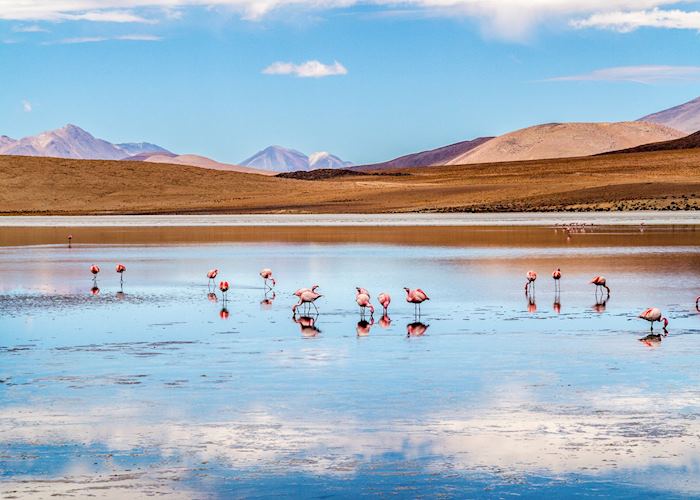
Our expert guides to travelling in Bolivia
Written by our specialists from the viewpoint of their own travels, these guides will help you decide on the shape of your own trip to Bolivia. Aiming to inspire and inform, we share our recommendations for how to appreciate Bolivia at its best.

A path less trodden: Bolivia
Bolivia is a lesser-known destination, but with many highlights to please the intrepid traveller, including the beautiful city of La Paz and the salt flats of Salar de Uyuni, there is plenty to explore.

Machu Picchu plus one: tried-and-tested South American combinations
Did you know that thanks to ever-improving flight connections, you can easily combine Machu Picchu with other South American destinations such as the Galapagos and Argentina — without the need to extend your trip drastically? Our specialists explain how.

The Inca civilisation
Discover the culture and history of a country on a tailor-made trip, with visits to explore famous sites and others not quite so well known but equally impressive.
Other popular destinations
Still looking for ideas? If Bolivia has captured your interest, we think you might also like these destinations.

Bolivia Tours & Holidays

Bold and brash, Bolivia lifts travellers to its dizzying heights with stunning scenery, legendary landmarks and a rich, indigenous heritage.
Bolivia is an energetic, enigmatic piece of South American sorcery – alive with passion, awash with colour, connected to the past but living very much in the present. Soak in thermal baths surrounded by erupting geysers and desert; marvel at ruins on Lake Titicaca’s Island of the Sun (the mythical birthplace of Inca civilization); saddle up and tour Old Sucre’s monastic buildings and, of course, check out the mega salt-lick of the Salar de Uyuni – it’s like being on a snowfield…but with flamingos!
Our Bolivia trips
Let's create an exclusive trip for your group.
Bolivia tour reviews
Filter by rating
Real Bolivia & Argentina
Bolivia Highlights
Best of Bolivia & Argentina
Articles of Bolivia
The top 7 destinations for travel in April 2024
Lonely Planet’s Ultimate Travel List is here
Everything you need to know about visiting the Amazon
Why you should visit Sucre, Bolivia’s most beautiful city
Everything you should do, see and eat in La Paz, Bolivia
Everything you need to know about Bolivia’s Salar de Uyuni
Is this Bolivia’s most incredible natural wonder? Your guide to Laguna Colorada
Why this is the worst photo from my trip to Bolivia
Bolivia at a glance
Capital city.
Sucre (constitutional, population 290,891); La Paz (administrative, population 1,908,000)
12.08 million
Bolivian boliviano (BOB)
Spanish, Quechua, Aymara, Guarani
(GMT-04:00) La Paz
CALLING CODE
Electricity.
Type A (North American/Japanese 2-pin) Type C (European 2-pin)
Learn more about Bolivia
Culture and customs.
Bolivia is a highly stratified nation where lifestyle and wealth vary greatly with geography. Cities tend to be wealthy and enjoy modern luxuries like art, theatre and international cuisine. Conversely, life in the rural highlands is tough. Many live without running water, heat and electricity. The highland population is almost entirely indigenous (the Quechua and the Aymara are the two largest groups) and most earn a living through farming.
What unifies many Bolivians is a love of family, soccer and religion. About 80% are Catholic, and practice with a mixture of indigenous customs and beliefs. This is how a place like the Witches Market, which sells tokens and trinkets meant to appease the Aymara gods, can coexist right next to the historic Church of San Francisco in La Paz. In fact, the church itself features carvings of masked figures, snakes, dragons and other indigenous symbols.
Regardless of wealth or socioeconomic status, Bolivians are taught to be well-mannered and to respect their elders. Visitors should remember to mind their p’s and q’s – say ‘por favor’ (please), ‘gracias’ (thank you) and remember to call anyone older than you ‘senor’ or ‘senora’. Just don’t expect a local to be punctual for an appointment – the nation as a whole is almost always fashionably late.
Food and drink
Bolivian cuisine varies with altitude. Spicy, carb-heavy Aymaran cuisine featuring potatoes, rice, quinoa and meat dominate the highlands, whereas lowland dishes are typically lighter, milder and focus more on yucca, fruit, vegetables and seafood.
Things to try in Bolivia
1. Saltenas
These baked hand-held pies are filled with meat, vegetables, eggs and olives. A popular breakfast choice, you’ll see vendors selling them on almost every corner in the morning. For a midday snack, opt for a tucumanas instead, which is similar to a saltenas but deep-fried instead of baked.
2. Sandwich de chola
This sandwich stuffed with roast pork, pickled vegetables and salsa is a food stall favourite in La Paz. Wash it down with a refreshing beer for the perfect cheap meal.
3. Anticuchos
Skewers of grilled cow heart, lathered in spicy peanut sauce and accompanied by a potato is the late-night snack of choice for most Bolivians.
Tea made from coca leaves (mate de coca) is a popular drink that doubles as an antidote to altitude sickness. Bolivians also drink a lot of trimate tea, a fragrant combination of chamomile, coca and anise
Geography and environment
This landlocked South American nation shares its border with Brazil, Paraguay, Argentina, Chile and Peru. The Andes Mountain range, containing dormant volcanoes and snow-capped peaks, occupy the western half of the country. A wide range of landscapes can be found within the high plains of these mountains, where flamingos, llamas and vicunas wander deserts dotted with lakes.
Dried up ancient lakes have produced several salt flats – including Salar de Uyuni, the largest salt flat in the world, containing 10 billion tonnes of salt. Lake Titicaca, the world’s highest navigable body of water, is located at the border with Peru, and the country’s largest city, La Paz, is nestled here 3,500 m above sea level. Mountains give way to rolling hills, narrow valleys and numerous rivers in the east. Fertile, semitropical valleys characterise the north-east, whereas semi-arid plains cover the southern region.
Traditional handicrafts are the primary goods on offer in Bolivia. Weavers from Sucre produce quality textiles in red and black designs. Artisans in Cochabamba are known for producing ceramics, whereas the lowlands around Santa Cruz, Trinidad and the Amazon Basin excel at crafts in tropical woods. Prices are generally cheaper at the point of original production, but in the absence of that, visit Calle Sagarnaga in La Paz for all your shopping needs. You’ll find thousands of stores here selling everything from alpaca sweaters to leather bags to good-luck charms. Or visit the Sunday market in Tarabuco – located about an hour outside of Sucre, it’s considered one of the best markets in Bolivia.
Keep in mind that bargaining is not part of the Bolivian culture, so prices are usually fixed, and most markets and vendors deal only with cash. When possible, try to carry small bills and coins as many vendors have difficulty making change for bills larger than BOB 10, especially in smaller towns.
Festivals and events
Copacabana festival de la virgen de candelaria.
This normally sleepy town on Lake Titicaca celebrates its patron saint (also known as the Dark Virgin of the Lake) with a big and boisterous bash each February. Parades, colourful costumes, music, traditional Aymara dancing and a whole lot of drinking and celebrating are part of this three-day affair.
Tarabuco Pujllay Festival
Each March, Tarabuco hosts a two-day fiesta to celebrate Bolivia’s 1816 victory over the Spanish. Whether you choose to take in the parade of musicians and dancers in colourful traditional costumes, shop the town’s famous Sunday market, or take a swig from the shared chicha gourd – there’s a lot going on at this important annual event.
Fiesta del Gran Poder (Festival of Great Power)
Part act of religious devotion, part riotous party, this massive annual event is all Aymaran. Each May or June, thousands of dancers decked in elaborate embroidered costumes dance and drink their way through the city to commemorate El Senor del Gran Poder (also known as Jesus Christ).
Oruro Carnival
Take all of the spectacle of Brazil’s famous carnival, add the dizzying heights of the Altiplano plains, and you have Oruro’s Carnival – Bolivia’s biggest cultural event and the best carnival party in the country.
Further reading
Bolivia travel faqs, do i need a covid-19 vaccine to join an intrepid trip.
Trips from 1 January 2023 onwards
From 1 January 2023, Intrepid will no longer require travellers to provide proof of vaccination against COVID-19 (excluding all Polar trips and select adventure cruises).
However, we continue to strongly recommend that all Intrepid travellers and leaders get vaccinated to protect themselves and others.
Specific proof of testing or vaccination may still be required by your destination or airline. Please ensure you check travel and entry requirements carefully.
Do I need a visa to visit Bolivia?
Visas are the responsibility of the individual traveller. Entry requirements can change at any time, so it's important that you check for the latest information. Please visit the relevant consular website of the country or countries you’re visiting for detailed and up-to-date visa information specific to your nationality. Check the Essential Trip Information section of the itinerary for more information.
Is tipping customary in Bolivia?
While tipping isn’t mandatory in Bolivia, it is customary to add spare change to restaurant bills. Many bars and restaurants add a 10% service charge to the bill.
What is the internet access like in Bolivia?
Internet can be accessed at hotels and internet cafes in large cities and tourist areas, but is limited in rural and remote areas. Internet is not accessible travelling through the Uyuni desert.
Can I use my mobile phone while in Bolivia?
Mobile phone coverage is generally good in Bolivia’s urban areas, but may not be available in more remote and mountainous areas. Ensure global roaming is activated with your service provider before leaving home.
What are the toilets like in Bolivia?
Bolivia has a mix of both Western-style flushable toilets and squat toilets. In some cases you may be asked for a small fee to use public toilets, which is used to pay cleaners. It’s a good idea to carry your own toilet paper and hand sanitizer, as they are not always provided.
What will it cost for a...?
City bus fare = 1.50 BOB Cup of coffee in a cafe = 10 BOB Bottle or can of beer = 10 BOB Simple lunch = 20-25 BOB Dinner in a restaurant = 80 BOB
Can I drink the tap water in Bolivia?
Drinking tap water isn’t recommended in Bolivia. Avoid drinks with ice and make sure to peel fruit before eating it. Help the environment and try to avoid buying bottled water. Instead, fill a reusable water bottle with filtered water. Ask your leader or the hotel where to find filtered water.
Are credit cards accepted widely in Bolivia?
Credit cards are usually accepted by hotels, large retailers and tourist sites but are less commonly accepted by smaller vendors and family-run restaurants and market stalls. Always carry enough cash for smaller purchases in case credit cards are not an option.
What is ATM access like in Bolivia?
ATMs are widely available in larger cities but are less common in small villages or rural areas. Make sure you have enough cash before leaving urban areas. ATMs are not accessible travelling through the Uyuni desert.
What public holidays are celebrated in Bolivia?
- 1 Jan: New Year’s Day
- 4 Mar: Carnival*
- 19 Apr: Good Friday*
- 1 May: Labour Day
- 20 Jun: Corpus Christi*
- 6 Aug: Independence Day
- 12 Oct: Columbus Day
- 2 Nov: All Saint’s Day
- 25 Dec: Christmas
*Please note these dates may vary. For a current list of public holidays in Bolivia please go to the World Travel Guide Website
Will I experience altitude sickness in Bolivia?
Most people can start to feel the effects of altitude at over 2000 m (6561 ft) regardless of age, gender or fitness level. While our leaders have basic first aid training and are aware of the closest medical facilities, it is very important that you make yourself aware of the cause and effects of travelling at altitude, monitor your health and seek assistance accordingly. It’s important to take it easy, drink plenty of water and speak to your group leader at once if you feel unwell.
We recommend seeing your doctor if you have any health concerns before undertaking the trip. Particularly if you have a pre-existing medical condition or take any medication.
Do I need any vaccinations before visiting Bolivia?
Bolivia requires proof of yellow fever vaccination if you are travelling from a country with risk of yellow fever. Many South and Central America countries pose a risk (including Argentina, Brazil and Colombia), so if you are planning on visiting other nearby nations, you may be required to get this vaccine. Please note that your home country may also require proof of yellow fever vaccination on return from Bolivia. Consult your nearest embassy for more information.
Visit your doctor or travel clinic for up-to-date advice and make sure to schedule your vaccination 4-6 weeks before your departure date, as some may require time to become effective. No other vaccines are required in order to enter Bolivia but some are recommended for protection against disease.
Is Bolivia a safe destination for LGBTQI-travellers?
Discretion is advised for LGBTQI-travellers in Bolivia. Same-sex unions are illegal and homosexuality is not widely accepted, although an underground gay scene can be found in larger cities, particularly Santa Cruz and La Paz.
For more detailed and up-to-date advice, we recommend visiting Equaldex or ILGA before you travel.
Do I need to purchase travel insurance before travelling?
Absolutely. All passengers travelling with Intrepid are required to purchase travel insurance before the start of their trip. Your travel insurance details will be recorded by your leader on the first day of the trip. Due to the varying nature, availability and cost of health care around the world, travel insurance is very much an essential and necessary part of every journey.
For more information on insurance, please go to: Travel Insurance
How do I stay safe and healthy while travelling?
Intrepid takes the health and safety of its travellers seriously and takes every measure to ensure that trips are safe, fun and enjoyable for everyone. We recommend that all travellers check with their government or national travel advisory organisation for the latest information before departure:
From Australia?
Go to: Smart Traveller
From Canada?
Go to: Canada Travel Information
From the UK?
Go to: UK Foreign Travel Advice
From New Zealand?
Go to: Safe Travel
From the US?
Go to: US Department of State
The World Health Organisation also provides useful health information.
Does my trip support The Intrepid Foundation?
Yes, all Intrepid trips support the Intrepid Foundation. Trips to this country directly support our global Intrepid Foundation partners Eden Reforestation Projects and World Bicycle Relief. Intrepid will double the impact by dollar-matching all post-trip donations made to The Intrepid Foundation.
Eden Reforestation Projects
Eden Reforestation Projects are helping to mitigate climate change by restoring forests worldwide; they also hire locally and create job opportunities within vulnerable communities. Donations from our trips support restoration across planting sites in 10 countries around the globe. Find out more or make a donation World Bicycle Relief
World Bicycle Relief provides people in low-income communities with bicycles to mobilise school kids, health workers, and farmers in far-out areas – giving them access to vital education, healthcare, and income. Donations help provide Buffalo Bicycles – specifically designed to withstand the rugged terrain and harsh environment of rural regions – to those who need them most. Find out more or make a donation
- Skip to main content
- Skip to "About this site"
Language selection
Search travel.gc.ca.
Help us to improve our website. Take our survey !
COVID-19: travel health notice for all travellers
Bolivia travel advice
Latest updates: Health – editorial update
Last updated: April 8, 2024 11:05 ET
On this page
Safety and security, entry and exit requirements, laws and culture, natural disasters and climate, bolivia - exercise a high degree of caution.
Exercise a high degree of caution in Bolivia due to the continuing political and social tensions and frequent illegal roadblocks throughout the country.
Back to top
Roadblocks are common, may be erected suddenly, and can lead to significant disruptions to traffic and public transportation. They have stranded travellers for several days. The following are particularly vulnerable to blockades:
- all roads in border areas, especially along the Bolivia–Peru border
- roads leading to international airports
- main roads leading to large cities
Before departure, check with your airline to determine if there are delays or changes in flight schedules.
If you plan to take a road trip:
- review your travel plans to determine if they will be affected by demonstrations or civil unrest
- take personal security measures
- monitor local media
Once a roadblock is in place, local authorities, officials and vendors will not be able to enter or exit the city to provide supplies to stranded travellers. As a precaution, you should take extra:
- warm clothing
Don't cross roadblocks, even if they appear unattended. This may aggravate the situation and lead to physical harm. Instead, consider:
- taking an alternative safer route
- returning to your place of departure
Road closures and blockages – Bolivian Highway Administrator (in Spanish)
Demonstrations
Demonstrations and labour strikes occur frequently, often with little or no notice. Even peaceful demonstrations can turn violent at any time. They can also lead to disruptions to traffic and public transportation. Protesters often use dynamite during protests.
- Avoid areas where demonstrations and large gatherings are taking place
- Follow the instructions of local authorities
- Monitor local media for information on ongoing demonstrations
Mass gatherings (large-scale events)
Petty crime
Petty crime, such as pickpocketing and purse snatching, is common in large cities, including La Paz and Santa Cruz. Thieves target tourist areas and public transport.
Criminals often operate in organized groups. They will distract victims while an accomplice steals from them. Strategies include:
- staging a fight
- starting a conversation or offering help
- blocking a sidewalk
- throwing an object or liquid on the victims, then offering to help clean up
- posing as a victim of crime
- posing as a law enforcement officer
- using a young child to lure a tourist to a separate location
To avoid becoming a victim of theft:
- ensure that your belongings, including your passport and other travel documents, are secure at all times
- don't travel alone, especially at night
- be cautious of strangers approaching you
- remain alert to your surroundings at all times
- avoid showing signs of affluence
- avoid carrying large sums of money
- keep cellphones, cameras and other electronic equipment out of sight
Violent and drug-related crime
Violent crime against tourists is uncommon but does occur. Foreigners have been victims of armed robberies and assaults at tourist destinations.
Violent crime, carjacking and civil unrest, mainly associated with drug trafficking, pose risks in:
- the Chapare area between Santa Cruz and Cochabamba
- the Yungas region, northeast of La Paz
- all borders with Argentina, Brazil, Chile, Paraguay and Peru
You should avoid visits to prisons offered by unscrupulous guides, as prison guards cannot guarantee your security.
Express kidnapping
Express kidnappings have occurred at tourist destinations. Criminals ask for small, immediate ransoms. The kidnappers usually force their victims to withdraw funds from an ATM or to arrange for family or friends to pay the ransom. This ploy is often used by criminal taxi drivers, who pick up the victim and then stop to pick up associates. These kidnappings are committed by organized gangs and occur throughout the country.
- Use only reputable taxi companies or ride-sharing apps
- Avoid hailing taxis on the street
- If armed criminals threaten you, cooperate and don't resist
Vehicle and auto-parts theft, as well as theft from vehicles, are a problem throughout Bolivia.
- Keep valuables in the trunk, and only when necessary
- Park your car in a supervised lot
- Keep windows and doors locked at all times
Credit card and ATM fraud
Credit card and ATM fraud occurs. When using debit or credit cards:
- Pay careful attention when others are handling your cards
- Use ATMs located in well-lit public areas or inside a bank or business
- Avoid using card readers with an irregular or unusual feature
- Cover the keypad with one hand when entering your PIN
- Check for any unauthorized transactions on your account statements
Fraudulent police officers
Criminals often pose as police officers and ask to examine the traveller's belongings or ask the traveller to accompany them to a bogus police station, sometimes in collusion with a criminal posing as a taxi driver or another passenger.
Under Bolivian law, there's no obligation to go with an officer to a police station unless they have a formal written request from a judge with your name on it. Any search or seizure must occur at a genuine police station in the presence of the prosecutor.
If you're stopped while travelling by someone claiming to be a local authority, ask to see their official identification.
Medical scams
Canadians visiting Bolivia for surgical procedures have reported falling victim to scams by medical companies that insist on retaining passports as collateral. Once the procedure is complete, the company attempts to extort more money from the patient before returning their passport.
If your passport is inaccessible due to such a situation, you may not be able to receive full passport services. You may also be subject to investigation by Passport Canada.
- Carefully research medical clinics if you plan to travel to Bolivia for medical services
- Never hand over your passport to anyone
Overseas fraud
Spiked food and drinks
Never leave food or drinks unattended or in the care of strangers. Be wary of accepting snacks, beverages, gum or cigarettes from new acquaintances, as the items may contain drugs that could put you at risk of sexual assault and robbery.
Women's safety
Women travelling alone may be subject to some forms of harassment and verbal abuse.
Sexual assaults occur periodically, including at clubs and hostels.
- Be cautious when dealing with strangers and new acquaintances
- Lock your room when you return to your hotel/hostel.
Advice for women travellers
Water activities
Rescue services may not be consistent with international standards.
- Consult residents and tour operators for information on possible hazards and safe swimming areas
- Follow the instructions and warnings of local authorities
If you take a boat tour:
- make sure the vessel you are boarding is carrying appropriate safety equipment and that life jackets are provided for all passengers and accessible at all times
- don't board vessels that appear overloaded or unsafe
- verify the safety standards of ferries with your tour operator
If in doubt about the safety of the facilities or equipment, don't use them.
Water safety abroad
Adventure tourism
There are no official minimum safety standards for tour operators.
Only participate in tours in Uyuni, jungle expeditions, boat trips, mountain biking and other adventure activities with well-established companies. Ensure that your travel insurance covers your recreational activities.
Hiking and trekking
Be vigilant when hiking or trekking:
- in the areas surrounding La Paz, such as the Muela del Diablo
- near Rurrenabaque
- the Bolivian Andes
- in the Yungas region
- on the Inca trail
Criminals have targeted tourists in these areas.
If you intend to hike or trek:
- never do so alone and always hire an experienced guide from a reputable company
- buy travel insurance that includes helicopter rescue and medical evacuation
- ensure that your physical condition is good enough to meet the challenges of your activity
- ensure that you're properly equipped and well informed about weather and other conditions that may pose a hazard
- inform a family member or friend of your itinerary
- know the symptoms of acute altitude sickness, which can be fatal
- stay away from stray dogs, which can be aggressive and carry rabies
- obtain detailed information on hiking routes before setting out and do not venture off marked trails or slopes
Spiritual cleansing ceremonies
Spiritual cleansing ceremonies involving hallucinogenic substances (ayahuasca, peyote, San Pedro, etc.) have led to serious illness, injury, assault and even the deaths of several tourists.
Ceremonies involve consuming substances that can cause medical complications and severely impair cognitive and physical abilities. They often take place in remote areas with no access to medical or mental health facilities or resources. Often, there is no access to communications with local authorities. Facilities generally lack basic first aid or emergency plans to help those suffering from physical or psychological illness during these ceremonies.
Spiritual cleansing ceremonies are not regulated and individuals offering them are not licensed. There is no way to assess the safety of any of the services or the operators.
Avoid participating in spiritual cleansing ceremonies using hallucinogenic substances.
Road safety
Road conditions and road safety are poor throughout the country. Accidents and fatalities are common.
Driving conditions may be hazardous during the rainy season.
Although improved highways connect Cochabamba, La Paz, Santa Cruz and Sucre, many roads in Bolivia are unpaved. The old Yungas road is considered one of the world's most dangerous roads.
Many vehicles are poorly maintained.
Outside major cities, four-wheel-drive vehicles are necessary, especially in mountainous areas.
Common road hazards include:
- narrow, winding roads
- lack of guardrails on mountain roads
- inadequate or non-existent street lighting
- lack of signage
- poorly marked construction sites
- unpaved roads and potholes
- unfavourable weather conditions, sometimes causing landslides
Many drivers lack formal training and don't respect traffic laws. They may drive:
- aggressively and recklessly
- at high speeds
- while intoxicated
- without lights turned on at night
Public transportation
Public transportation, including buses, trains, shared and unlicensed taxis, and mini-buses, is unsafe. The level of crime is high in vehicles and at transportation hubs. Accidents are common due to:
- poor maintenance of vehicles
- lack of safety standards
- poor road conditions
Local and intercity buses are frequently involved in traffic accidents, especially overnight buses. Accidents involving less reputable, poorly maintained tourist buses have caused injuries and fatalities among tourists.
Use only tour buses operated by well-known, reputable companies for trips. If you have any doubt about the safety of a bus or its driver, use another company.
If you choose to travel by intercity bus, exercise caution in:
- La Paz bus terminals, including the main bus terminal on Peru Avenue in Zona Norte, the terminal near the La Paz cemetery, and the Minasa terminal in Zona Villa Fatima, due to petty crime
- the Santa Cruz bus/train terminal, where violent crimes against foreigners have occurred
- Coronilla Hill, adjacent to the main bus terminal in Cochabamba, due to assaults
Many taxis are poorly maintained and may not have functional seatbelts.
Avoid hailing taxis on the street. Instead, call radio taxi companies that are registered with authorities from a landline or from a hotel. Radio taxis are identifiable by the telephone number and name of the taxi company on the vehicle's roof.
- Take note of the taxi's registration and telephone numbers before you depart
- Pay special attention when taking taxis to and from airports, particularly in Santa Cruz and La Paz, where bandits are known to rob tourists
- Decline transportation from people offering cheaper fares
- Never share a taxi with strangers
- Avoid taking motorcycle taxis
- Negotiate the fare with the driver before departure, as taxis are not equipped with meters
We do not make assessments on the compliance of foreign domestic airlines with international safety standards.
Information about foreign domestic airlines
Every country or territory decides who can enter or exit through its borders. The Government of Canada cannot intervene on your behalf if you do not meet your destination’s entry or exit requirements.
We have obtained the information on this page from the Bolivian authorities. It can, however, change at any time.
Verify this information with the Foreign Representatives in Canada .
Entry requirements vary depending on the type of passport you use for travel.
Before you travel, check with your transportation company about passport requirements. Its rules on passport validity may be more stringent than the country’s entry rules.
Regular Canadian passport
Your passport must be valid for at least 6 months from the date you arrive in Bolivia.
Passport for official travel
Different entry rules may apply.
Official travel
Passport with “X” gender identifier
While the Government of Canada issues passports with an “X” gender identifier, it cannot guarantee your entry or transit through other countries. You might face entry restrictions in countries that do not recognize the “X” gender identifier. Before you leave, check with the closest foreign representative for your destination.
Other travel documents
Different entry rules may apply when travelling with a temporary passport or an emergency travel document. Before you leave, check with the closest foreign representative for your destination.
Useful links
- Foreign Representatives in Canada
- Canadian passports
Tourist visa: not required for stays up to 30 days Business visa: required Student visa: required Volunteer work visa: required
Registration
All foreign residents and tourists must register their home or accommodation address online, using the web-based registration process (SIGEMIG). This can be done prior to arrival in Bolivia.
If you have not completed the electronic registration prior to arriving in Bolivia, immigration inspectors at the port of entry will register you and give you further instructions. Your registration must include lodging information for your entire stay. If you fail to comply, you will be subject to fines upon leaving the country.
Address registration – General Directorate of Migration (in Spanish)
Extensions of stay
If you’re a tourist wishing to stay for more than 30 days, you must apply at the General Directorate of Migration to obtain a tourist visa for another 30 days before the end of the first 30-day period. This extension can be obtained twice, at no extra cost and to a maximum of 90 days during one calendar year.
If you have overstayed the 90-day period without proper authorization, you may be fined upon departure.
General Directorate of Migration - Government of Bolivia
Other entry and exit requirements
Customs officials may ask you to show them a return or onward ticket and proof of sufficient funds to cover your stay.
Immigration officials will give you an immigration card when you arrive. Make sure to keep it, as they will ask for it when you leave the country.
When arriving by land, ensure your passport receives an exit stamp from the country you’re leaving and an entry stamp from Bolivia. If you fail to do so, you’ll be fined upon departure. Avoid travelling at night, when border officials and police may not be present.
Children and travel
Bolivia has strict requirements for the entry and exit of persons under the age of 18, including special documentation.
Parents of children travelling alone, with 1 parent or with another individual are strongly encouraged to contact the nearest Bolivian embassy or consulate before departure to ensure that the latest entry and exit requirements, which may change without notice, are met.
- Travelling with children
Yellow fever
Learn about potential entry requirements related to yellow fever (vaccines section).
Relevant Travel Health Notices
- Global Measles Notice - 13 March, 2024
- Zika virus: Advice for travellers - 31 August, 2023
- COVID-19 and International Travel - 13 March, 2024
- Dengue: Advice for travellers - 8 April, 2024
This section contains information on possible health risks and restrictions regularly found or ongoing in the destination. Follow this advice to lower your risk of becoming ill while travelling. Not all risks are listed below.
Consult a health care professional or visit a travel health clinic preferably 6 weeks before you travel to get personalized health advice and recommendations.
Routine vaccines
Be sure that your routine vaccinations , as per your province or territory , are up-to-date before travelling, regardless of your destination.
Some of these vaccinations include measles-mumps-rubella (MMR), diphtheria, tetanus, pertussis, polio, varicella (chickenpox), influenza and others.
Pre-travel vaccines and medications
You may be at risk for preventable diseases while travelling in this destination. Talk to a travel health professional about which medications or vaccines may be right for you, based on your destination and itinerary.
Yellow fever is a disease caused by a flavivirus from the bite of an infected mosquito.
Travellers get vaccinated either because it is required to enter a country or because it is recommended for their protection.
- There is a risk of yellow fever in this country.
Country Entry Requirement*
- Proof of vaccination is required if you are coming from a country where yellow fever occurs.
Recommendation
- Vaccination is recommended depending on your itinerary.
- Contact a designated Yellow Fever Vaccination Centre well in advance of your trip to arrange for vaccination.
- Discuss travel plans, activities, and destinations with a health care professional.
- Protect yourself from mosquito bites .
About Yellow Fever
Yellow Fever Vaccination Centres in Canada * It is important to note that country entry requirements may not reflect your risk of yellow fever at your destination. It is recommended that you contact the nearest diplomatic or consular office of the destination(s) you will be visiting to verify any additional entry requirements.
There is a risk of hepatitis A in this destination. It is a disease of the liver. People can get hepatitis A if they ingest contaminated food or water, eat foods prepared by an infectious person, or if they have close physical contact (such as oral-anal sex) with an infectious person, although casual contact among people does not spread the virus.
Practise safe food and water precautions and wash your hands often. Vaccination is recommended for all travellers to areas where hepatitis A is present.
Hepatitis B is a risk in every destination. It is a viral liver disease that is easily transmitted from one person to another through exposure to blood and body fluids containing the hepatitis B virus. Travellers who may be exposed to blood or other bodily fluids (e.g., through sexual contact, medical treatment, sharing needles, tattooing, acupuncture or occupational exposure) are at higher risk of getting hepatitis B.
Hepatitis B vaccination is recommended for all travellers. Prevent hepatitis B infection by practicing safe sex, only using new and sterile drug equipment, and only getting tattoos and piercings in settings that follow public health regulations and standards.
Measles is a highly contagious viral disease. It can spread quickly from person to person by direct contact and through droplets in the air.
Anyone who is not protected against measles is at risk of being infected with it when travelling internationally.
Regardless of where you are going, talk to a health care professional before travelling to make sure you are fully protected against measles.
Coronavirus disease (COVID-19) is an infectious viral disease. It can spread from person to person by direct contact and through droplets in the air.
It is recommended that all eligible travellers complete a COVID-19 vaccine series along with any additional recommended doses in Canada before travelling. Evidence shows that vaccines are very effective at preventing severe illness, hospitalization and death from COVID-19. While vaccination provides better protection against serious illness, you may still be at risk of infection from the virus that causes COVID-19. Anyone who has not completed a vaccine series is at increased risk of being infected with the virus that causes COVID-19 and is at greater risk for severe disease when travelling internationally.
Before travelling, verify your destination’s COVID-19 vaccination entry/exit requirements. Regardless of where you are going, talk to a health care professional before travelling to make sure you are adequately protected against COVID-19.
The best way to protect yourself from seasonal influenza (flu) is to get vaccinated every year. Get the flu shot at least 2 weeks before travelling.
The flu occurs worldwide.
- In the Northern Hemisphere, the flu season usually runs from November to April.
- In the Southern Hemisphere, the flu season usually runs between April and October.
- In the tropics, there is flu activity year round.
The flu vaccine available in one hemisphere may only offer partial protection against the flu in the other hemisphere.
The flu virus spreads from person to person when they cough or sneeze or by touching objects and surfaces that have been contaminated with the virus. Clean your hands often and wear a mask if you have a fever or respiratory symptoms.
Malaria is a serious and sometimes fatal disease that is caused by parasites spread through the bites of mosquitoes. There is a risk of malaria in certain areas and/or during a certain time of year in this destination.
Antimalarial medication may be recommended depending on your itinerary and the time of year you are travelling. Consult a health care professional or visit a travel health clinic before travelling to discuss your options. It is recommended to do this 6 weeks before travel, however, it is still a good idea any time before leaving. Protect yourself from mosquito bites at all times: • Cover your skin and use an approved insect repellent on uncovered skin. • Exclude mosquitoes from your living area with screening and/or closed, well-sealed doors and windows. • Use insecticide-treated bed nets if mosquitoes cannot be excluded from your living area. • Wear permethrin-treated clothing. If you develop symptoms similar to malaria when you are travelling or up to a year after you return home, see a health care professional immediately. Tell them where you have been travelling or living.
In this destination, rabies is commonly carried by dogs and some wildlife, including bats. Rabies is a deadly disease that spreads to humans primarily through bites or scratches from an infected animal. While travelling, take precautions , including keeping your distance from animals (including free-roaming dogs), and closely supervising children.
If you are bitten or scratched by a dog or other animal while travelling, immediately wash the wound with soap and clean water and see a health care professional. In this destination, rabies treatment may be limited or may not be available, therefore you may need to return to Canada for treatment.
Before travel, discuss rabies vaccination with a health care professional. It may be recommended for travellers who are at high risk of exposure (e.g., occupational risk such as veterinarians and wildlife workers, children, adventure travellers and spelunkers, and others in close contact with animals).
Safe food and water precautions
Many illnesses can be caused by eating food or drinking beverages contaminated by bacteria, parasites, toxins, or viruses, or by swimming or bathing in contaminated water.
- Learn more about food and water precautions to take to avoid getting sick by visiting our eat and drink safely abroad page. Remember: Boil it, cook it, peel it, or leave it!
- Avoid getting water into your eyes, mouth or nose when swimming or participating in activities in freshwater (streams, canals, lakes), particularly after flooding or heavy rain. Water may look clean but could still be polluted or contaminated.
- Avoid inhaling or swallowing water while bathing, showering, or swimming in pools or hot tubs.
Travellers' diarrhea is the most common illness affecting travellers. It is spread from eating or drinking contaminated food or water.
Risk of developing travellers' diarrhea increases when travelling in regions with poor standards of hygiene and sanitation. Practise safe food and water precautions.
The most important treatment for travellers' diarrhea is rehydration (drinking lots of fluids). Carry oral rehydration salts when travelling.
Typhoid is a bacterial infection spread by contaminated food or water. Risk is higher among children, travellers going to rural areas, travellers visiting friends and relatives or those travelling for a long period of time.
Travellers visiting regions with a risk of typhoid, especially those exposed to places with poor sanitation, should speak to a health care professional about vaccination.
Insect bite prevention
Many diseases are spread by the bites of infected insects such as mosquitoes, ticks, fleas or flies. When travelling to areas where infected insects may be present:
- Use insect repellent (bug spray) on exposed skin
- Cover up with light-coloured, loose clothes made of tightly woven materials such as nylon or polyester
- Minimize exposure to insects
- Use mosquito netting when sleeping outdoors or in buildings that are not fully enclosed
To learn more about how you can reduce your risk of infection and disease caused by bites, both at home and abroad, visit our insect bite prevention page.
Find out what types of insects are present where you’re travelling, when they’re most active, and the symptoms of the diseases they spread.
There is a risk of chikungunya in this country. The risk may vary between regions of a country. Chikungunya is a virus spread through the bite of an infected mosquito. Chikungunya can cause a viral disease that typically causes fever and pain in the joints. In some cases, the joint pain can be severe and last for months or years.
Protect yourself from mosquito bites at all times. There is no vaccine available for chikungunya.
Cutaneous and mucosal leishmaniasis causes skin sores and ulcers. It is caused by a parasite spread through the bite of a female sandfly.
Risk is generally low for most travellers. Protect yourself from sandfly bites, which typically occur after sunset in rural and forested areas and in some urban centres. There is no vaccine or medication to protect against leishmaniasis.
- In this country, dengue is a risk to travellers. It is a viral disease spread to humans by mosquito bites.
- Dengue can cause flu-like symptoms. In some cases, it can lead to severe dengue, which can be fatal.
- The level of risk of dengue changes seasonally, and varies from year to year. The level of risk also varies between regions in a country and can depend on the elevation in the region.
- Mosquitoes carrying dengue typically bite during the daytime, particularly around sunrise and sunset.
- Protect yourself from mosquito bites . There is no vaccine or medication that protects against dengue.
Zika virus is a risk in this country.
Zika virus is primarily spread through the bite of an infected mosquito. It can also be sexually transmitted. Zika virus can cause serious birth defects.
During your trip:
- Prevent mosquito bites at all times.
- Use condoms correctly or avoid sexual contact, particularly if you are pregnant.
If you are pregnant or planning a pregnancy, you should discuss the potential risks of travelling to this destination with your health care provider. You may choose to avoid or postpone travel.
For more information, see Zika virus: Pregnant or planning a pregnancy.
American trypanosomiasis (Chagas disease) is a risk in this country. It is caused by a parasite spread by infected triatomine bugs. The infection can be inactive for decades, but humans can eventually develop complications causing disability and even death.
Risk is generally low for most travellers. Protect yourself from triatomine bugs, which are active at night, by using mosquito nets if staying in poorly-constructed housing. There is no vaccine available for Chagas disease.
Animal precautions
Some infections, such as rabies and influenza, can be shared between humans and animals. Certain types of activities may increase your chance of contact with animals, such as travelling in rural or forested areas, camping, hiking, and visiting wet markets (places where live animals are slaughtered and sold) or caves.
Travellers are cautioned to avoid contact with animals, including dogs, livestock (pigs, cows), monkeys, snakes, rodents, birds, and bats, and to avoid eating undercooked wild game.
Closely supervise children, as they are more likely to come in contact with animals.
Person-to-person infections
Stay home if you’re sick and practise proper cough and sneeze etiquette , which includes coughing or sneezing into a tissue or the bend of your arm, not your hand. Reduce your risk of colds, the flu and other illnesses by:
- washing your hands often
- avoiding or limiting the amount of time spent in closed spaces, crowded places, or at large-scale events (concerts, sporting events, rallies)
- avoiding close physical contact with people who may be showing symptoms of illness
Sexually transmitted infections (STIs) , HIV , and mpox are spread through blood and bodily fluids; use condoms, practise safe sex, and limit your number of sexual partners. Check with your local public health authority pre-travel to determine your eligibility for mpox vaccine.
Tuberculosis is an infection caused by bacteria and usually affects the lungs.
For most travellers the risk of tuberculosis is low.
Travellers who may be at high risk while travelling in regions with risk of tuberculosis should discuss pre- and post-travel options with a health care professional.
High-risk travellers include those visiting or working in prisons, refugee camps, homeless shelters, or hospitals, or travellers visiting friends and relatives.
Medical services and facilities
Quality of health care varies greatly throughout the country. Good health care is available only in private hospitals in larger cities. Public medical services and facilities don’t meet Canadian standards. There’s limited access to health care facilities in rural areas, and very limited ambulance service throughout Bolivia. Evacuation by air ambulance can be difficult. Some air ambulance providers are unable to fly into locations at higher altitudes, such as La Paz.
Many clinics and hospitals accept payment in cash only. They may require upfront payment or refuse to allow you to leave their premises until you’ve paid for services.
Medical evacuation can be very expensive. You may need it in case of serious illness or injury.
Make sure you get travel insurance that includes coverage for medical evacuation and hospital stays.
Travel health and safety
If you take prescription medications, it’s your responsibility to determine their legality in Bolivia.
- Bring sufficient quantities with you
- Always keep them in the original container
- Pack them in your carry-on luggage
- Carry a copy of your prescriptions
Some prescription medications are considered as narcotics in Bolivia. Consult the list of controlled substances to avoid trouble.
Bolivia’s list of controlled substances – Vice Ministry of Social Defence and Controlled Substances (in Spanish)
Altitude sickness
Some parts of Bolivia, including La Paz, Salar de Uyuni and Lake Titicaca, are located at high altitudes. Some travellers may develop altitude sickness, which can be fatal. Seek medical attention if you develop symptoms.
Travel to High Altitudes – U.S. Centers for Disease Control and Prevention
Keep in Mind...
The decision to travel is the sole responsibility of the traveller. The traveller is also responsible for his or her own personal safety.
Be prepared. Do not expect medical services to be the same as in Canada. Pack a travel health kit , especially if you will be travelling away from major city centres.
You must abide by local laws.
Learn about what you should do and how we can help if you are arrested or detained abroad .
Bolivian drug laws include a zero tolerance policy. Penalties for possession, use or trafficking of illegal drugs are severe. Convicted offenders can expect lengthy prison sentences and heavy fines.
Travellers have fallen victim to scams in which illegal drugs are hidden inside objects or luggage that an acquaintance has asked them to bring to or take away from Bolivia. Dating websites are reportedly a source of such scams.
- Pack your own luggage
- Never transport luggage or packages on behalf of another person
Unlicensed bars
Unlicensed bars in Bolivia are illegal. They are known to sell drugs and should be avoided. Police may detain and question you if they raid the establishment, even if you’re not consuming any illegal substances.
Drugs, alcohol and travel
It’s illegal to export any item that the Bolivian government considers a national treasure ( patrimonio cultural ) without formal written permission from the Ministry of Culture, including:
- pre-Columbian artifacts
- historical paintings
- items of Spanish colonial architecture and history
- native textiles
- flora, fauna and fossils
Any type of excavation for fossils or collection of fossils without prior written authorization is illegal.
Identification
Police and immigration officials occasionally conduct identification checks. Carry copies of the identification and Bolivian entry stamp pages of your passport when you’re out.
Photography
Locals may find the presence of photographers intrusive, particularly in remote areas.
- Be careful when travelling with cameras and communications devices
- Ask for permission before you photograph people, especially children
2SLGBTQI+ travellers
Bolivian law does not prohibit sexual acts between individuals of the same sex.
Homosexuality is increasingly socially accepted, but much of Bolivian society remains conservative. 2SLGBTQI+ travellers could be discriminated against based on their sexual orientation, gender identity, gender expression or sex characteristics.
Travel and your sexual orientation, gender identity, gender expression and sex characteristics
Dual citizenship
Dual citizenship is legally recognized in Bolivia.
If you are a Canadian citizen, but also a citizen of Bolivia, our ability to offer you consular services may be limited while you're there. You may also be subject to different entry/exit requirements .
Travellers with dual citizenship
Military service
Military service is compulsory in Bolivia. Males aged 18 or over who are dual citizens must undertake military service upon arrival in the country.
International Child Abduction
The Hague Convention on the Civil Aspects of International Child Abduction is an international treaty. It can help parents with the return of children who have been removed to or retained in certain countries in violation of custody rights. It does not apply between Canada and Bolivia.
If your child was wrongfully taken to, or is being held in Bolivia by an abducting parent:
- act as quickly as you can
- consult a lawyer in Canada and in Bolivia to explore all the legal options for the return of your child
- report the situation to the nearest Canadian government office abroad or to the Vulnerable Children’s Consular Unit at Global Affairs Canada by calling the Emergency Watch and Response Centre.
If your child was removed from a country other than Canada, consult a lawyer to determine if The Hague Convention applies.
Be aware that Canadian consular officials cannot interfere in private legal matters or in another country’s judicial affairs.
- International Child Abduction: A Guidebook for Left-Behind Parents
- Canadian embassies and consulates by destination
- Emergency Watch and Response Centre
You must carry an international driving permit to rent or drive a vehicle.
The legal blood alcohol limit is 0.00%. If the police suspect you of drinking and driving, they could confiscate your driver’s licence on the spot and apply heavy fines and jail sentences.
If you’re involved in a traffic accident, remain at the scene until local police arrive. Attempting to leave the scene violates Bolivian law.
International Driving Permit
The currency in Bolivia is the boliviano (BOB).
Credit and debit cards are not widely accepted outside urban centres. Carry small bank notes to facilitate daily transactions such as:
- street food
U.S. dollars are widely accepted. There is a shortage of U.S. dollars. Banks and ATMs are currently not dispensing U.S. dollars.
It’s difficult to exchange Canadian dollars in Bolivia. Bring U.S. dollars if you need to exchange cash.
Rainy season
Flooding and landslides.
Heavy rains have caused severe flooding and landslides in Bolivia, resulting in evacuations and casualties. The floods have caused significant damage to buildings and infrastructure, particularly in the departments of Pando and La Paz.
The following essential services could be disrupted:
- transportation
- power distribution
- fuel supply
- water and food supply
- telecommunications networks
- emergency services
- medical care
If you're in Bolivia:
- stay away from the affected areas
- exercise caution
- monitor local news and weather reports
- follow the instructions of local authorities, including evacuation orders
Weather alerts – National Meteorological and Hydrological Service (in Spanish)
The rainy season extends from November to March.
Seasonal flooding can hamper overland travel and reduce the provision of essential services. Roads may become impassable and bridges damaged. Heavy rains may contribute to dangerous landslides. In particular, the Uyuni Salt Flats become dangerous to visit in the rainy season.
If you decide to travel to Bolivia during the rainy season:
- know that you expose yourself to serious risks
- be prepared to change your travel plans on short notice, including cutting short or cancelling your trip
- stay informed of the latest regional weather forecasts
- carry emergency contact information for your airline or tour operator
- follow the advice and instructions of local authorities
There is a risk of forest fires during the dry season, from July to October. The air quality in areas near active fires may deteriorate due to heavy smoke.
In case of a significant fire:
- stay away from affected areas, particularly if you suffer from respiratory ailments
- monitor local media for up-to-date information on the situation
- follow the advice of local authorities
Latest alerts – Vice Ministry of Civil Defence
Local services
In case of emergency, dial:
- police: 110
- firefighters: 119
- gender-based violence: 800-14-0348
- ambulance service in La Paz: 165
- tourist police in La Paz: +591-2-222-5016
Consular assistance
For emergency consular assistance, call the Embassy of Canada to Bolivia (Program Office), in La Paz, and follow the instructions. At any time, you may also contact the Emergency Watch and Response Centre in Ottawa.
The decision to travel is your choice and you are responsible for your personal safety abroad. We take the safety and security of Canadians abroad very seriously and provide credible and timely information in our Travel Advice to enable you to make well-informed decisions regarding your travel abroad.
The content on this page is provided for information only. While we make every effort to give you correct information, it is provided on an "as is" basis without warranty of any kind, expressed or implied. The Government of Canada does not assume responsibility and will not be liable for any damages in connection to the information provided.
If you need consular assistance while abroad, we will make every effort to help you. However, there may be constraints that will limit the ability of the Government of Canada to provide services.
Learn more about consular services .
Risk Levels
take normal security precautions.
Take similar precautions to those you would take in Canada.
Exercise a high degree of caution
There are certain safety and security concerns or the situation could change quickly. Be very cautious at all times, monitor local media and follow the instructions of local authorities.
IMPORTANT: The two levels below are official Government of Canada Travel Advisories and are issued when the safety and security of Canadians travelling or living in the country or region may be at risk.
Avoid non-essential travel
Your safety and security could be at risk. You should think about your need to travel to this country, territory or region based on family or business requirements, knowledge of or familiarity with the region, and other factors. If you are already there, think about whether you really need to be there. If you do not need to be there, you should think about leaving.
Avoid all travel
You should not travel to this country, territory or region. Your personal safety and security are at great risk. If you are already there, you should think about leaving if it is safe to do so.
Cookies on GOV.UK
We use some essential cookies to make this website work.
We’d like to set additional cookies to understand how you use GOV.UK, remember your settings and improve government services.
We also use cookies set by other sites to help us deliver content from their services.
You have accepted additional cookies. You can change your cookie settings at any time.
You have rejected additional cookies. You can change your cookie settings at any time.
beta This is a test version of the layout of this page. Take the survey to help us improve it
- Help and services around the world
- UK help and services in Bolivia
Travelling to Bolivia
Includes travel advice and how to get married abroad.
Subscriptions
- Get emails for this topic Travelling to Bolivia
Bolivia travel advice
FCDO travel advice for Bolivia. Includes safety and security, insurance, entry requirements and legal differences.
Getting married abroad
Requirements, paperwork and processes for weddings and civil partnerships overseas - registration, restrictions, fees
Reduce your risk from terrorism while abroad
How to minimise your risk, and what to do if there's a terrorist attack.
Is this page useful?
- Yes this page is useful
- No this page is not useful
Help us improve GOV.UK
Don’t include personal or financial information like your National Insurance number or credit card details.
To help us improve GOV.UK, we’d like to know more about your visit today. We’ll send you a link to a feedback form. It will take only 2 minutes to fill in. Don’t worry we won’t send you spam or share your email address with anyone.
Situation in Haiti April 5, 2024
U.s. citizens in haiti, update january 10, 2024, information for u.s. citizens in the middle east.
- Travel Advisories |
- Contact Us |
- MyTravelGov |
Find U.S. Embassies & Consulates
Travel.state.gov, congressional liaison, special issuance agency, u.s. passports, international travel, intercountry adoption, international parental child abduction, records and authentications, popular links, travel advisories, mytravelgov, stay connected, legal resources, legal information, info for u.s. law enforcement, replace or certify documents.
Share this page:
Bolivia Travel Advisory
Travel advisory june 6, 2023, bolivia - level 2: exercise increased caution.
Reissued with updates to health information.
Exercise increased caution in Bolivia due to civil unrest. Some areas have increased risk. Read the entire Travel Advisory.
Do not travel to:
- Chapare region due to crime .
Reconsider travel to:
- Yungas region due to crime .
Country Summary: Demonstrations, strikes, and roadblocks can occur at any time in Bolivia. Demonstrations can result in violence. Roadblocks and strikes may cut off traffic and restrict the flow of goods and services around the country. Domestic and international flights may be delayed or unexpectedly cancelled.
Read the country information page for additional information on travel to Bolivia.
If you decide to travel to Bolivia :
- Monitor local media for breaking events and be prepared to adjust your plans.
- Contact your airline or travel agency prior to travel.
- Avoid demonstration and crowds.
- Enroll in the Smart Traveler Enrollment Program ( STEP ) to receive Alerts and make it easier to locate you in an emergency.
- Follow the Department of State on Facebook , Twitter , and Instagram .
- Review the Country Security Report for Bolivia.
- Prepare a contingency plan for emergency situations. Review the Traveler’s Checklist .
Chapare Region: Do Not Travel
Due to a high level of violent crime , the U.S. government is limited in its ability to provide emergency services to U.S. citizens in the Chapare region. U.S. government employees must obtain special authorization to travel there.
Visit our website for Travel to High-Risk Areas .
Yungas Region: Reconsider Travel
Organized criminal groups near Corioco and Carnavi in Yungas have committed carjackings and robberies . The U.S. government is limited in its ability to provide emergency services to U.S. citizens in the Yungas area. U.S. government employees must obtain special authorization to travel there.
Travel Advisory Levels
Assistance for u.s. citizens, bolivia map, search for travel advisories, external link.
You are about to leave travel.state.gov for an external website that is not maintained by the U.S. Department of State.
Links to external websites are provided as a convenience and should not be construed as an endorsement by the U.S. Department of State of the views or products contained therein. If you wish to remain on travel.state.gov, click the "cancel" message.
You are about to visit:

COMMENTS
Travel and sale of alcohol ban 22-23 March. There is a national travel ban on 23 March, seek local advice about travel to the airport if you have a flight. The sale of alcohol will also be banned ...
To enter Bolivia, your passport should have an 'expiry date' at least 6 months after the date you arrive. Check with your travel provider that your passport and other travel documents meet ...
Read this travel advice and carry out your own research before deciding whether to travel. Emergency services in Bolivia. Ambulance: 118. Police: 110. Fire: 119. Contact your travel provider and ...
It's normal to greet someone with a polite buenos días (good morning), buenos tardes (good afternoon) or buenos noches (good night). When addressing people, use señor or señora (Mr or Mrs) or a formal title such as doctor where appropriate. Stick to the formal usted ("you") for people you don't know well, rather than the informal tú.
Check the latest government guidance on the FCDO Foreign travel advice and country specific pages for travel to this country and the rules for entering the UK on return. Ensure you are up to date with UK recommendations on COVID-19 vaccination. Check if you are at increased risk of severe COVID-19. You can check this in the FAQ's.
Find continuously updated travel restrictions for Bolivia such as border, vaccination, COVID-19 testing, and quarantine requirements.
Bolivia travel guide - essential info. Below is a beginner's guide to Bolivia with essential travel facts such as dominant language spoken, typical flight time from the UK and the local currency. You can also check whether visas are required and what plug adapter you need to pack. Bolivia - quick facts. Time difference. UK -4 hours. Language (s ...
Reports of a "coup" in Bolivia in November and clashes on the streets of La Paz led the Foreign Office (FCO) to advise against all but essential travel. However, the warning was recently lifted .
The first thing (and most important) that you need to know before you travel to Bolivia is how to get into the country. When visiting Bolivia, every nationality falls into one of these four groups for tourism: 1. No Visa is required. 2. Visa required but can be acquired upon arrival at the border. 3.
Travellers should always check the UK Foreign, Commonwealth & Development Office (FCDO) travel advice and their country-specific pages for the latest COVID-19 travel advisories which may include information on travel restrictions, quarantine, COVID-19 testing or vaccination requirements. This includes considering the recommendations and ...
If you want to travel to Bolivia you must know whether or not a visa is required to enter the country. All US citizens are required to purchase an entry visa (USD$160). For citizens of other countries, the Bolivian government has divided countries into three groups. 1 st group: Countries that do not require the visa.
Costs. Bolivia is one of the least expensive countries in South America, and considerably cheaper than neighbouring Chile, Brazil and Argentina. Imported goods are expensive, but food, accommodation and transport are all relatively cheap, and travellers on a tight budget should be able to get around on Bs140/$20/£12/€14 per day, staying in basic hotels and eating set meals in local restaurants.
Foreign travel advice. Get advice about travelling abroad, including the latest information on coronavirus, safety and security, entry requirements and travel warnings. Search for a country or ...
Travel advice for Bolivia. From travel safety to visa requirements, discover the best tips for traveling to Bolivia. Eating and drinking in Bolivia; ... The Rough Guides to Bolivia and related travel guides. In-depth, easy-to-use travel guides filled with expert advice. Buy US$34.99. Buy US$34.99. Buy US$29.99.
LATEST BOLIVIA COVID-19 NEWS: 29th April 2022 - Bolivia no longer requires unvaccinated travellers to quarantine upon arrival. From 26th January 2022, vaccination certificates (or negative PCR test results taken within the last 48 hours) will be required to enter any public building (including banks, bars and supermarkets), buses and internal ...
Crossing the Paraguayan border In the dry season(May-Sept) you can enter Bolivia on the arduous bus journey from Asunción in the south of Paraguay to Santa Cruz (roughly 1000km/24hr). The Rough Guides to Bolivia and related travel guides. In-depth, easy-to-use travel guides filled with expert advice. Buy US$34.99.
Specific. Advice. Travellers'. Diarrhea Kits. Available. Bolivia is a beautiful, geographically diverse country. With regions of the Andes as well as the basin of the Amazon, it is the ultimate destination for a taste of what South America has to offer. There are a variety of one-of-a-kind places in Bolivia. If you want to a taste of the rich ...
Peru. Speak to a specialist to start planning your tailor-made holiday to Bolivia... Call one of our experts or arrange a video appointment for ideas and advice. 01993 838 645. Make an enquiry. Nick. Latin America Specialist. Graham. Peru, Bolivia & Chile Specialist.
At least 8 weeks before your trip check: the latest information on vaccinations and health risks in TravelHealthPro's Bolivia guide. where to get vaccines and whether you have to pay on the NHS ...
Call us in Washington, D.C. at 1-888-407-4747 (toll-free in the United States and Canada) or 1-202-501-4444 (from all other countries) from 8:00 a.m. to 8:00 p.m., Eastern Standard Time, Monday through Friday (except U.S. federal holidays). See the State Department's travel website for the Worldwide Caution and Travel Advisories.
Bolivia is an energetic, enigmatic piece of South American sorcery - alive with passion, awash with colour, connected to the past but living very much in the present. Soak in thermal baths surrounded by erupting geysers and desert; marvel at ruins on Lake Titicaca's Island of the Sun (the mythical birthplace of Inca civilization); saddle up and tour Old Sucre's monastic buildings and, of ...
To avoid becoming a victim of theft: ensure that your belongings, including your passport and other travel documents, are secure at all times. don't travel alone, especially at night. be cautious of strangers approaching you. remain alert to your surroundings at all times. avoid showing signs of affluence.
Bolivia travel advice. FCDO travel advice for Bolivia. Includes safety and security, insurance, entry requirements and legal differences.
Read the entire Travel Advisory. Do not travel to: Chapare region due to crime. Reconsider travel to: Yungas region due to crime. Country Summary: Demonstrations, strikes, and roadblocks can occur at any time in Bolivia. Demonstrations can result in violence. Roadblocks and strikes may cut off traffic and restrict the flow of goods and services ...